The flight down over the desert alone was worth the ticket. In some weird way it reminds me of the Reef, in a strange, upside down sort of way. You know when you take a photo and add the “negative” filter over it, so all the colours are inverted? Exactly the same here. Instead of water, there is an ocean of sand. Dunes and rocky outcroppings provide the breaks in the undulating white and tan of the sand, creating pools of iridescent shimmer in the endless, unbreaking landscape. Over time, the dun and bone colours give way to rust, and then this deep, rich, mineral red blanketing the earth as far as the eye can see, carpeted over with shrubbery of every size. There are scrub bushes of a deep hunter green, then brilliant green grasses, then acid coloured tall whispy stalks that look reminiscent of wheat. The red sand peeps from between these clusters of vegetation, and in between them lie blackened tree stumps or branches. I am not sure what makes them look so charred, whether fire or drought, but they are perfect colour palette. And all I can do is look around me, mouth lolling open, disbelieving that I’m here.

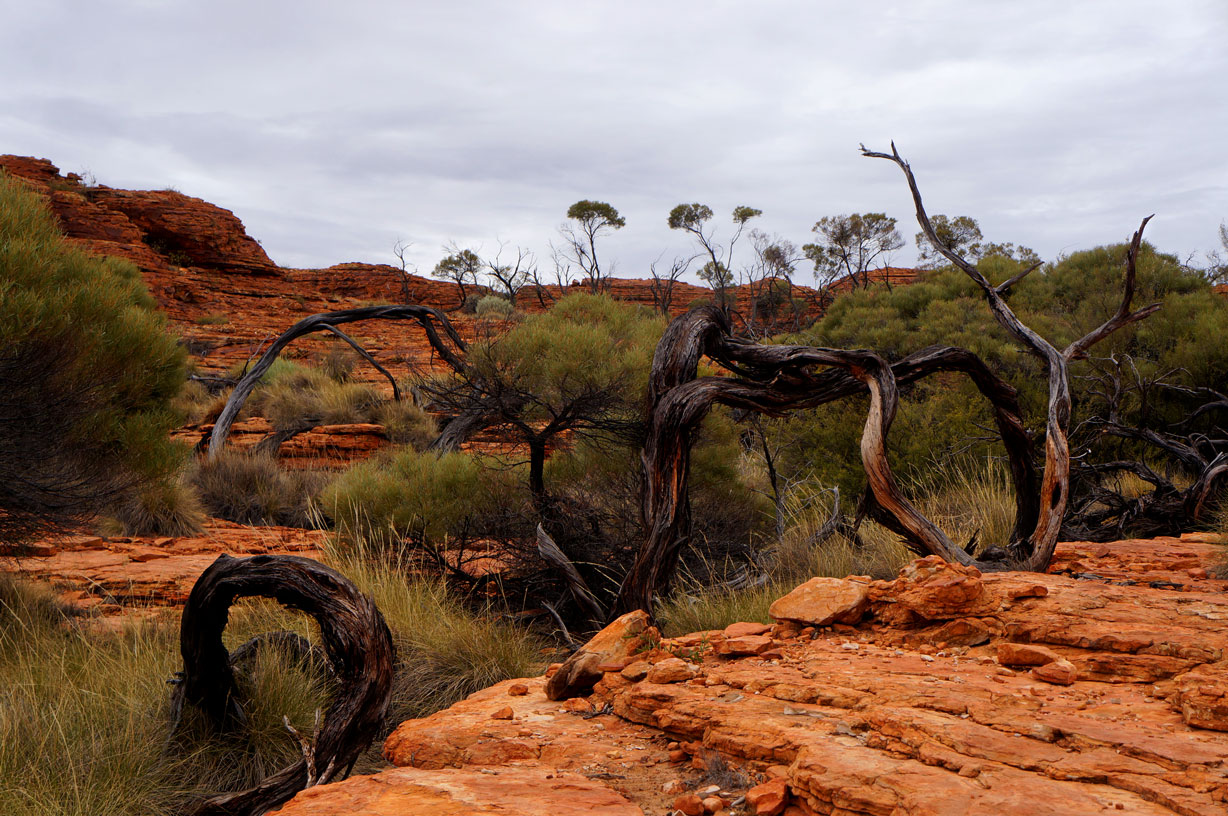

The wilderness and vastness is humbling. Suddenly, the superlatives used to describe space here just become fact. I am also amazed at how alive and lush, in its own way, this place is. I have half a mind to wrap my ankles up in bandages in case we encounter a snake on a hike, but the only danger seems to be the endless sand flies that will not stop chewing on my legs. I had to wear jeans today because by some freak all of Australia south of Airlie Beach has decided to turn cold – it’s barely 20 degrees out here and I’ve had to bust out the down jacket in the desert – and the biters left a ring of itchy bumps around my ankles right where the jeans ended.
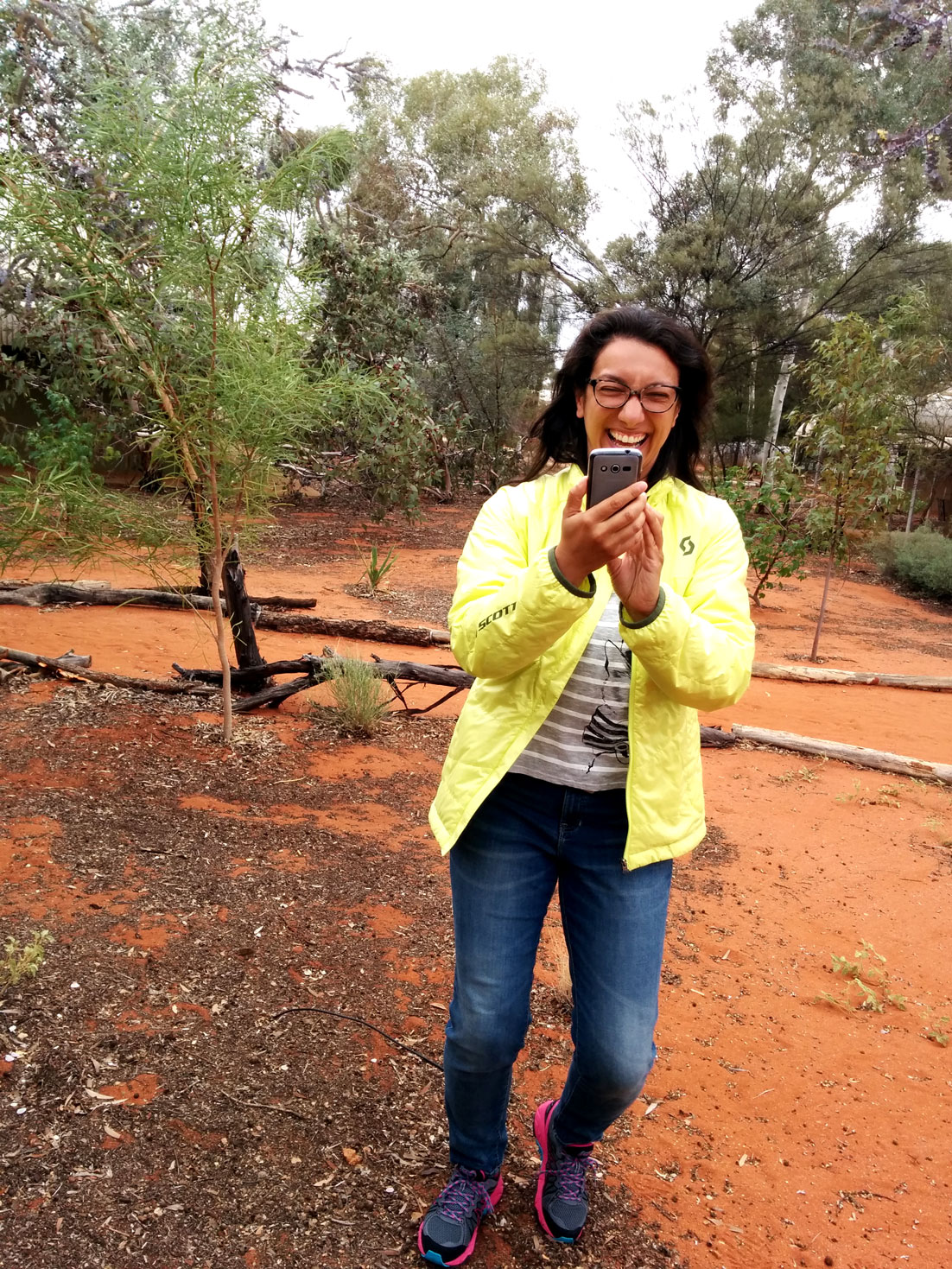
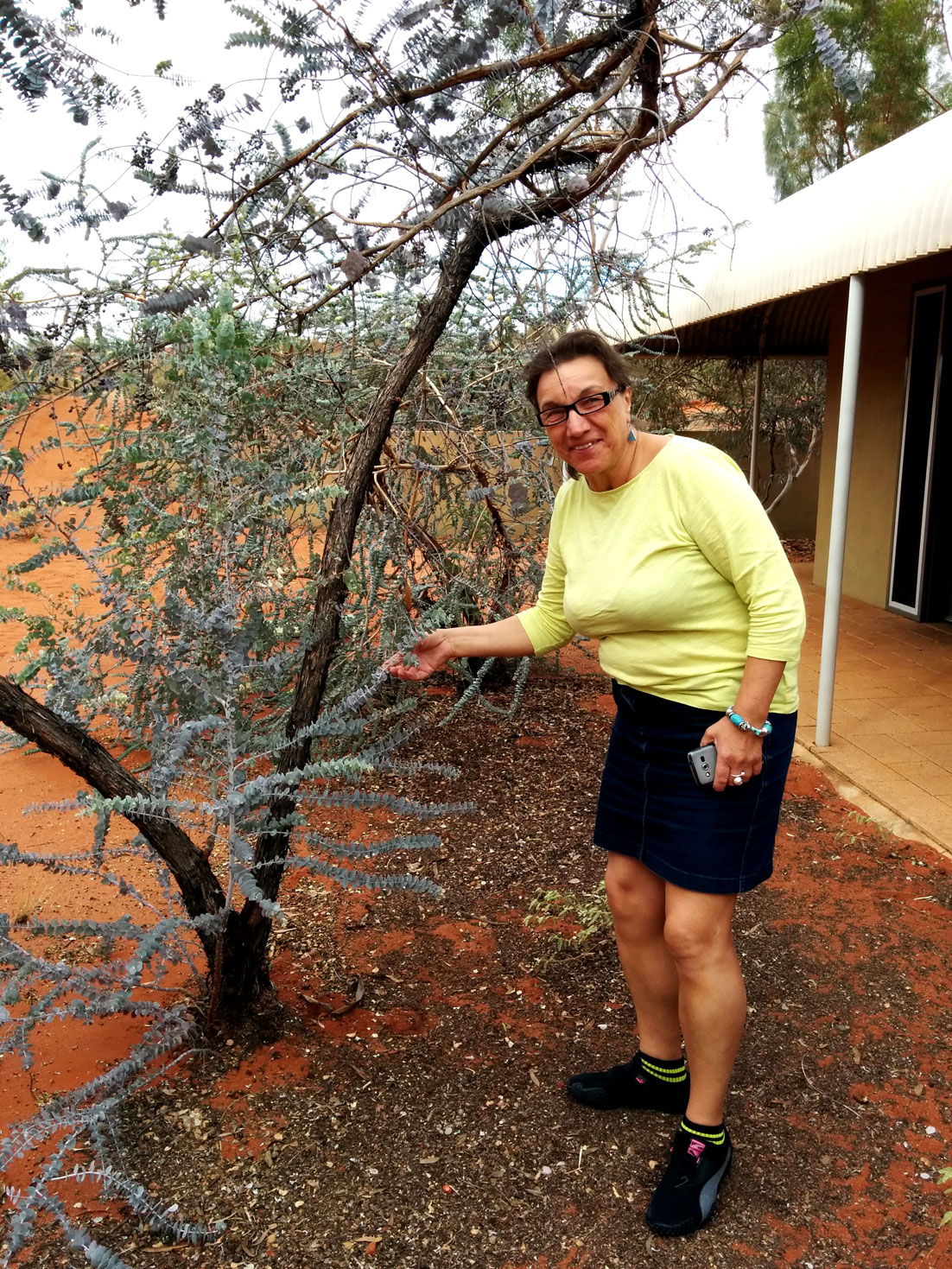
The buzz-buzz flies are a bitch too, as they seem to favour the heat, or the oils, or the whatever, but they’re constantly trying to land on my face. I’m getting an Akubra (as long as it’s not black, as I’ve been told it means you get down with the horses, literally) and I can totally see why the station hands of yore put corks on string from the brim, bobbing with each step, discouraging the flies. I haven’t seen any of those in the gift shops though. Clearly, the only thing to do is keep drinking wine and collecting the corks.
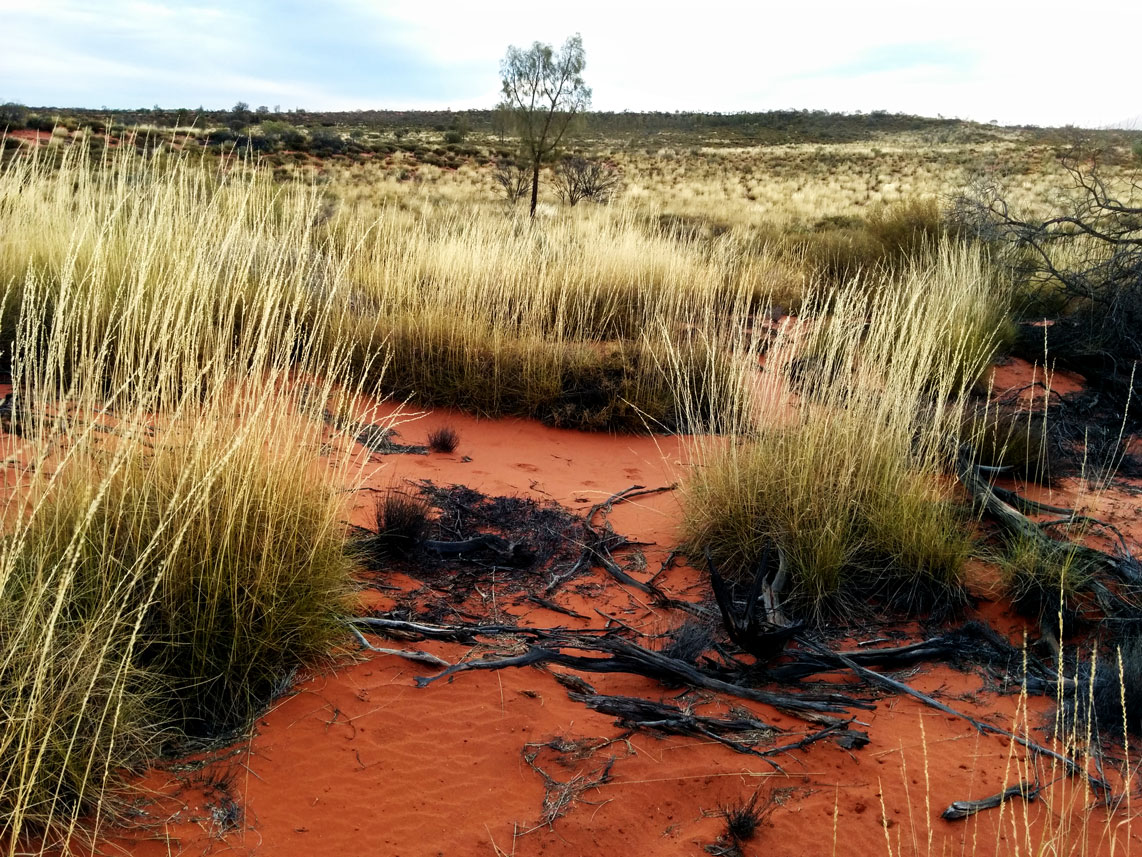
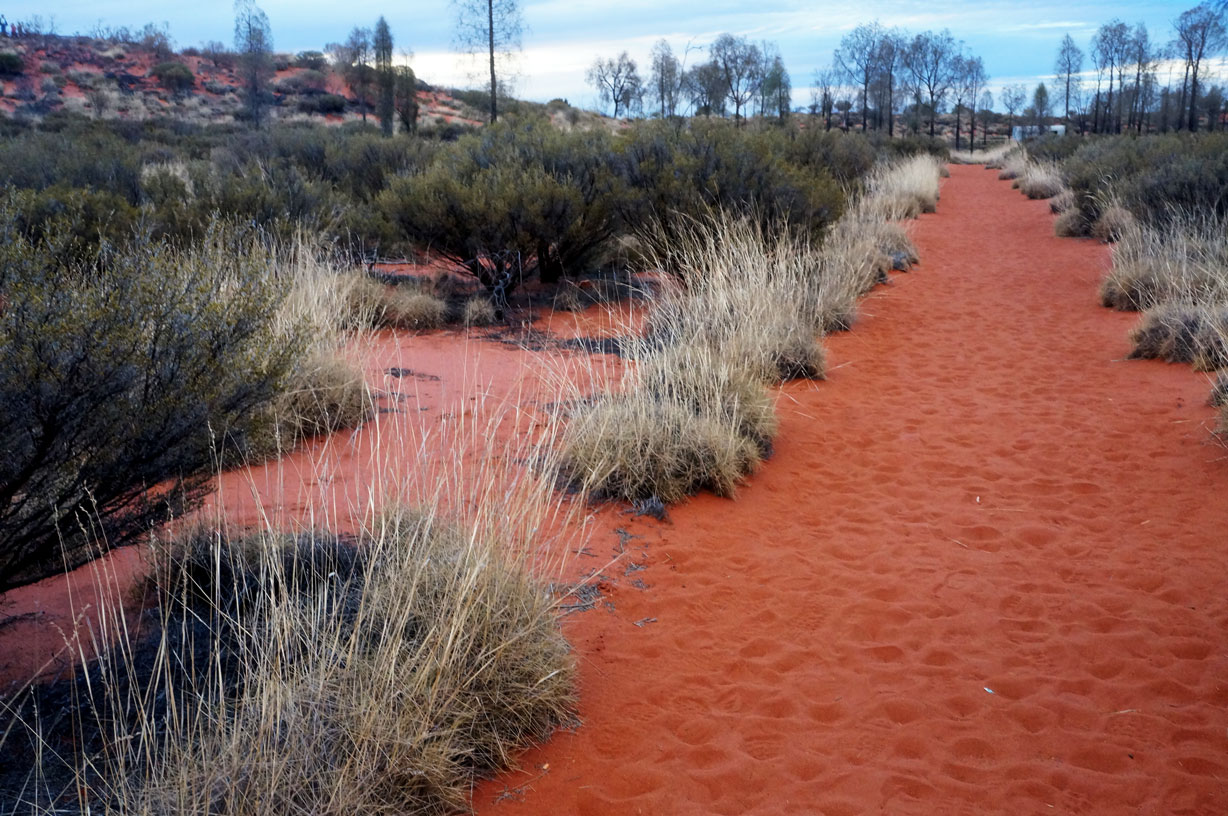
From the airport, we took a “free” shuttle bus to the oasis town of Yulara, the only non-native community for hundreds of kilometers in any direction. The Outback Pioneer Hotel and Lodge, where we stayed overnight, was an incredibly clean, comfortable hotel. It is in fact four hotel/resorts clustered together along with a camp-ground and the little shopping enclave. It also houses the staff of the resorts and support workers for Uluru- Kata Tjuta National Park. All supplies are brought via 18-wheeler, and it is the only hub of internet connectivity in an otherwise dead-zone. You have to drive a good 4-6 hours depending on direction before picking up any signal. Our room was set up along hostel lines, with a 4-sleeper and an ensuite, but I think there are cabins that are more like private hotels. The staff are very friendly and helpful, and the accommodations spare, but very clean and very comfortable. The Lodge had a bar and restaurant area, as well as a BBQ pit, but turns out you have to buy the meat from them and cook it yourself, instead of buying the meat at the grocery. There was a billiard table and a swimming pool, of all things, which I thought was a little odd. I mean, I know it gets hot and you may want to take a swim, but still…it seems a bit out of touch with the environment we are in. It’s clearly a response to tourist demands and tastes, and I know many families are probably thrilled they can throw their kids into the pool on hot summer days, but oy. To be perfectly fair though, if it had been 32 degrees, I would probably have been the first in the pool, staring out at Uluru, as it is only 18 km from it. In fact you can see the Rock from any of the observation sand dunes around the resort.

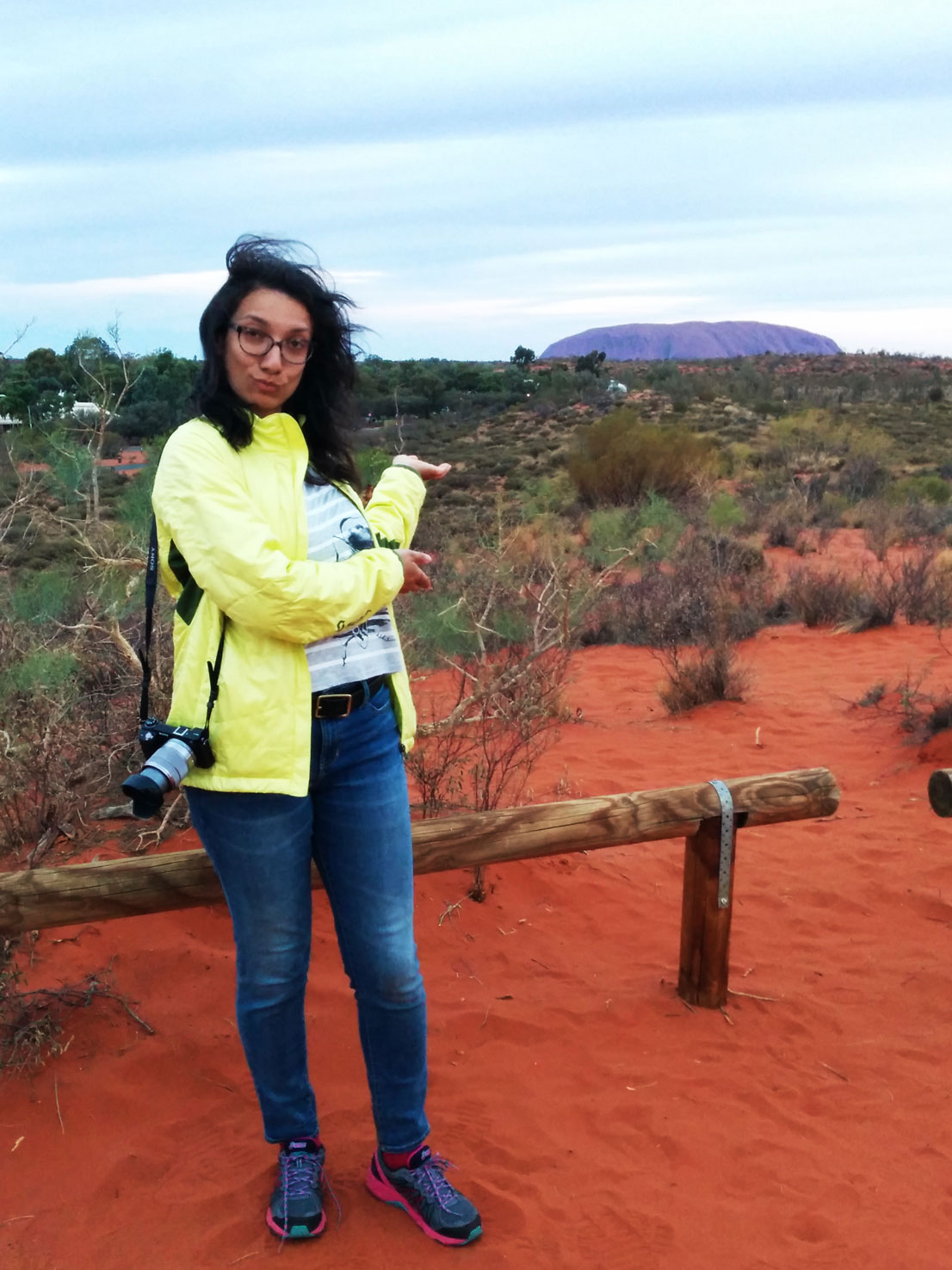
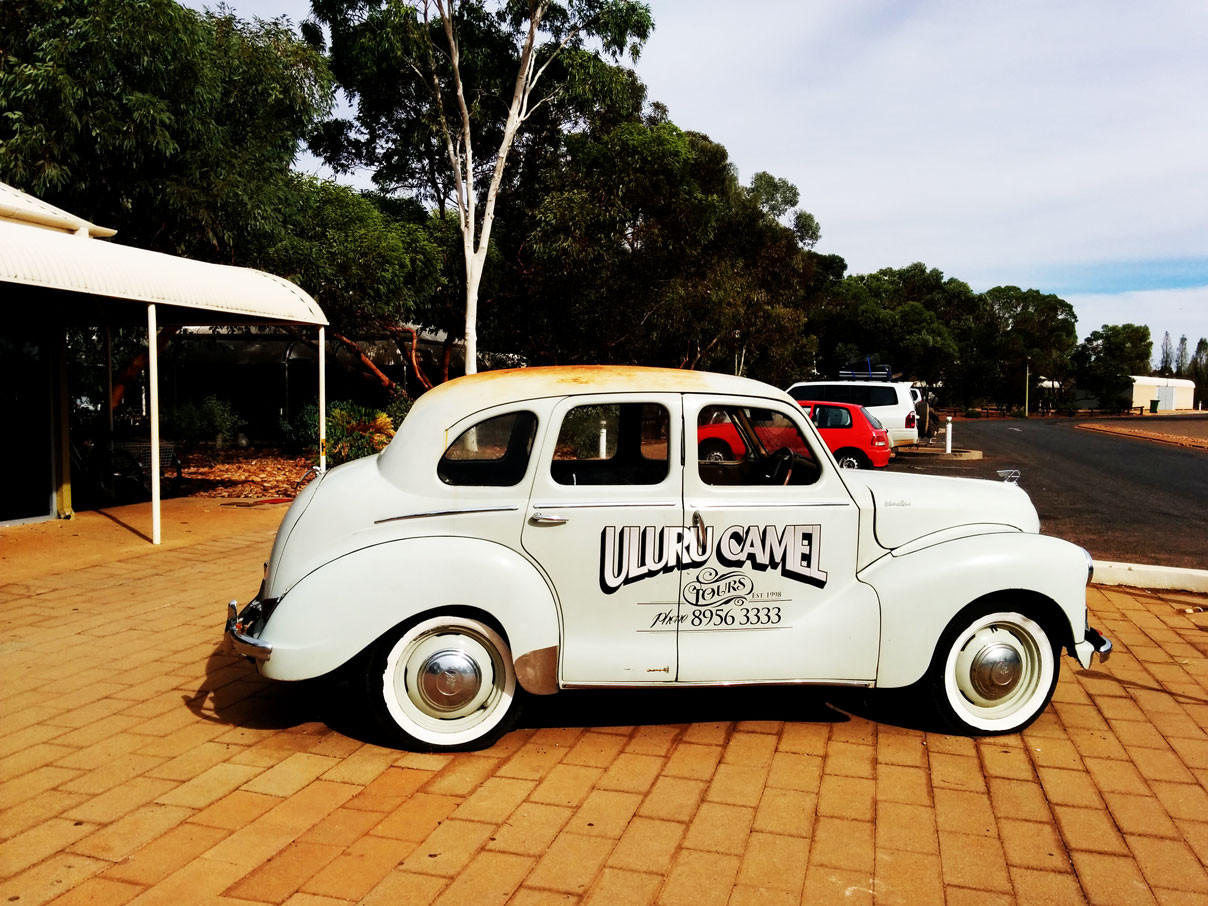
Particular dunes with good lines of sight towards the rock have little paths created, either with stones on either side, or have had the scrub removed. There are little platforms at the tops of the dunes, outfitted with guardrails and benches, and you can see the red rock rise above the green ground vegetation. It seems that there is a fairly significant water table underneath the sand here. We were told that wherever you see a tree that grows perfectly vertical, it is a desert oak, and it means there is water under the soil, for the oaks send their roots down to find water before it starts growing upward. So when you see a lot of oaks, you can be reasonably assured that someone is busy tapping the water under the trees for personal use.
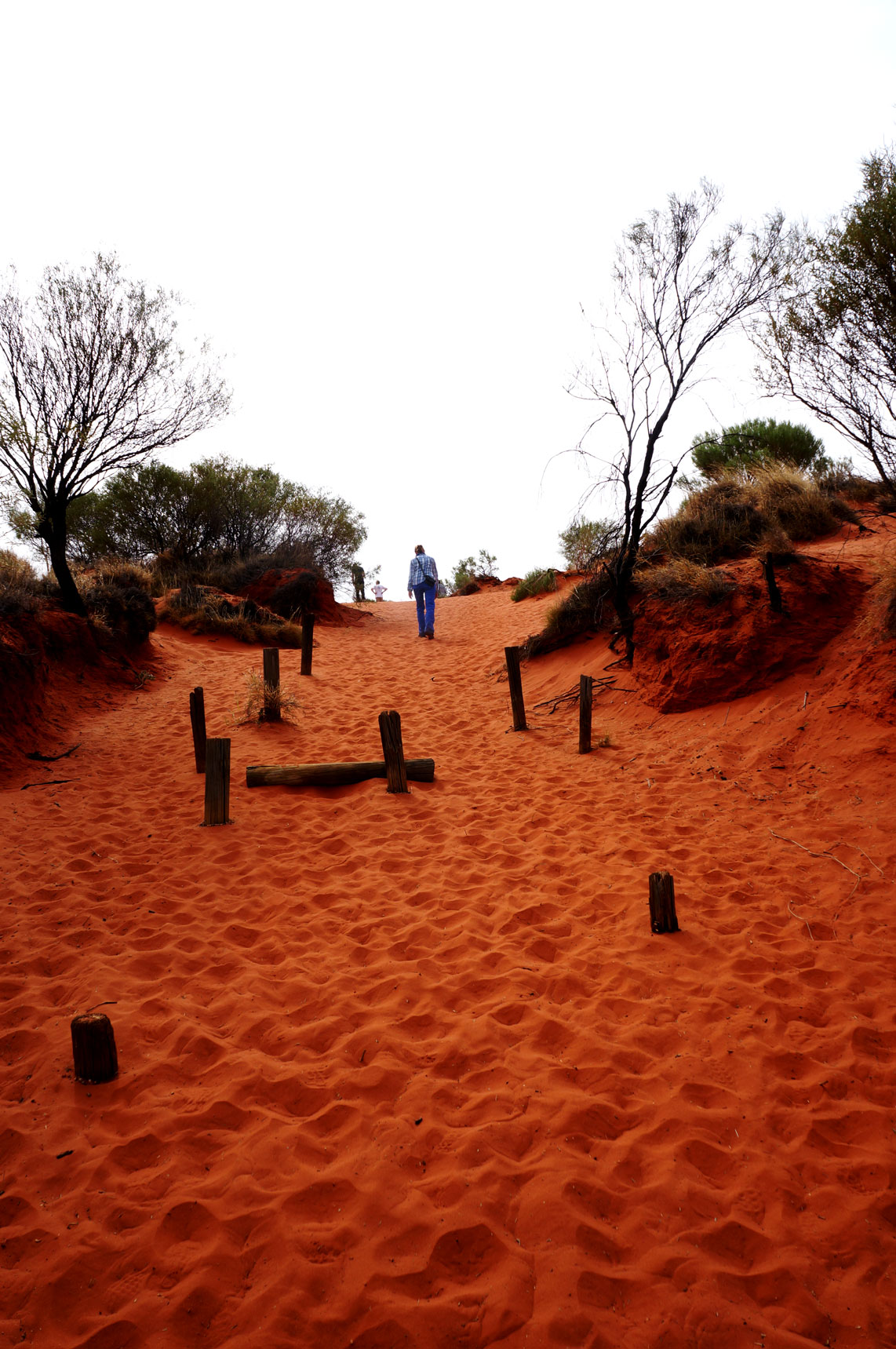
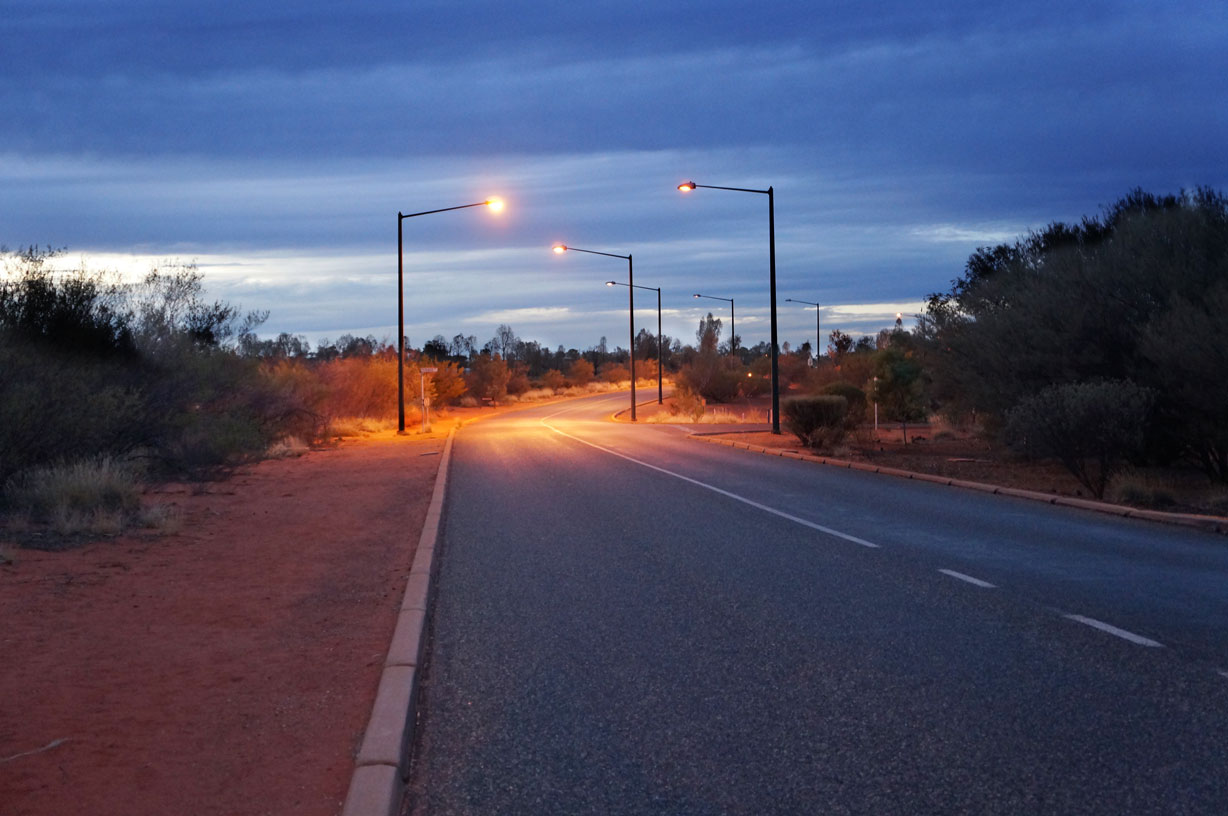
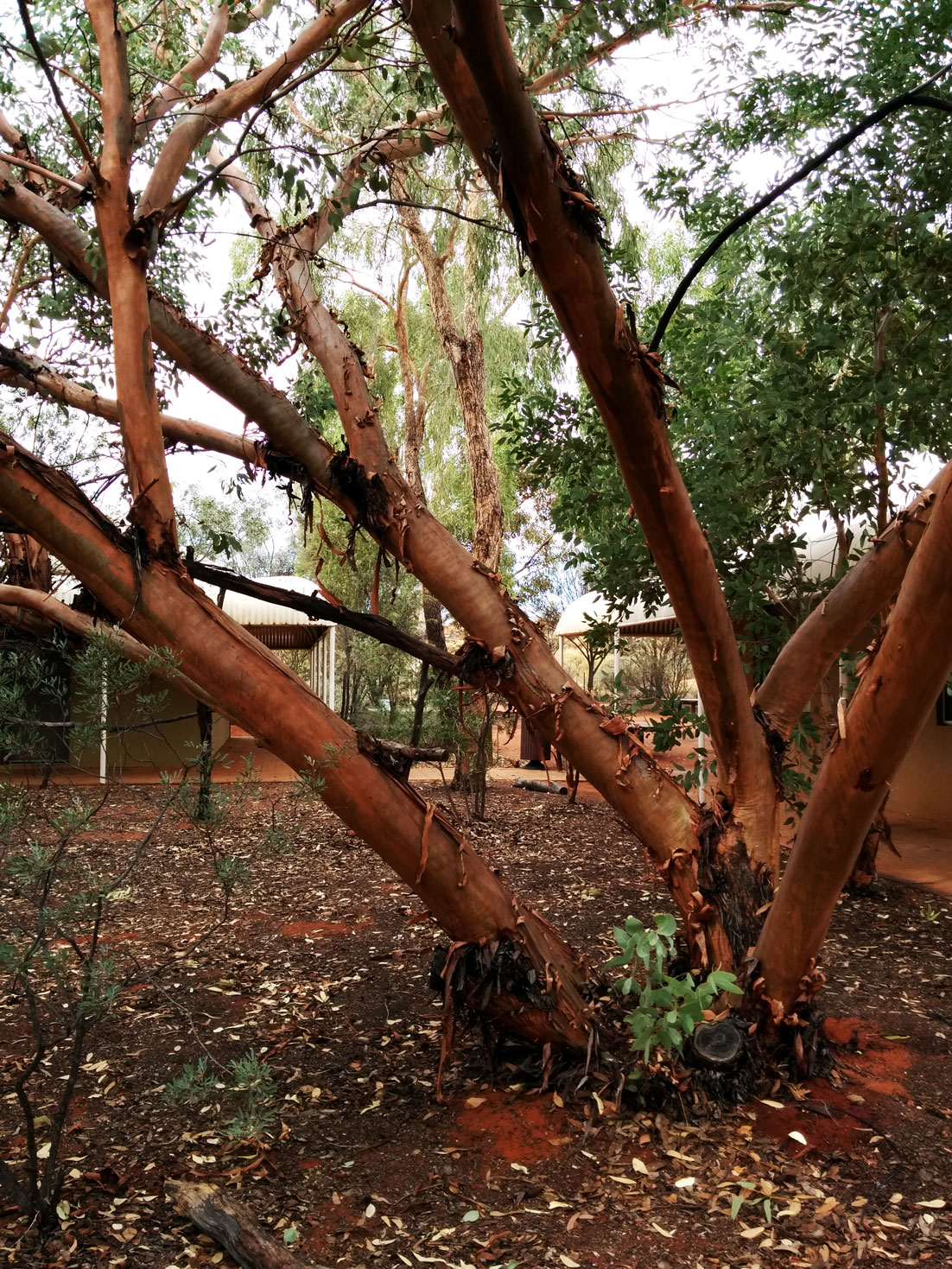
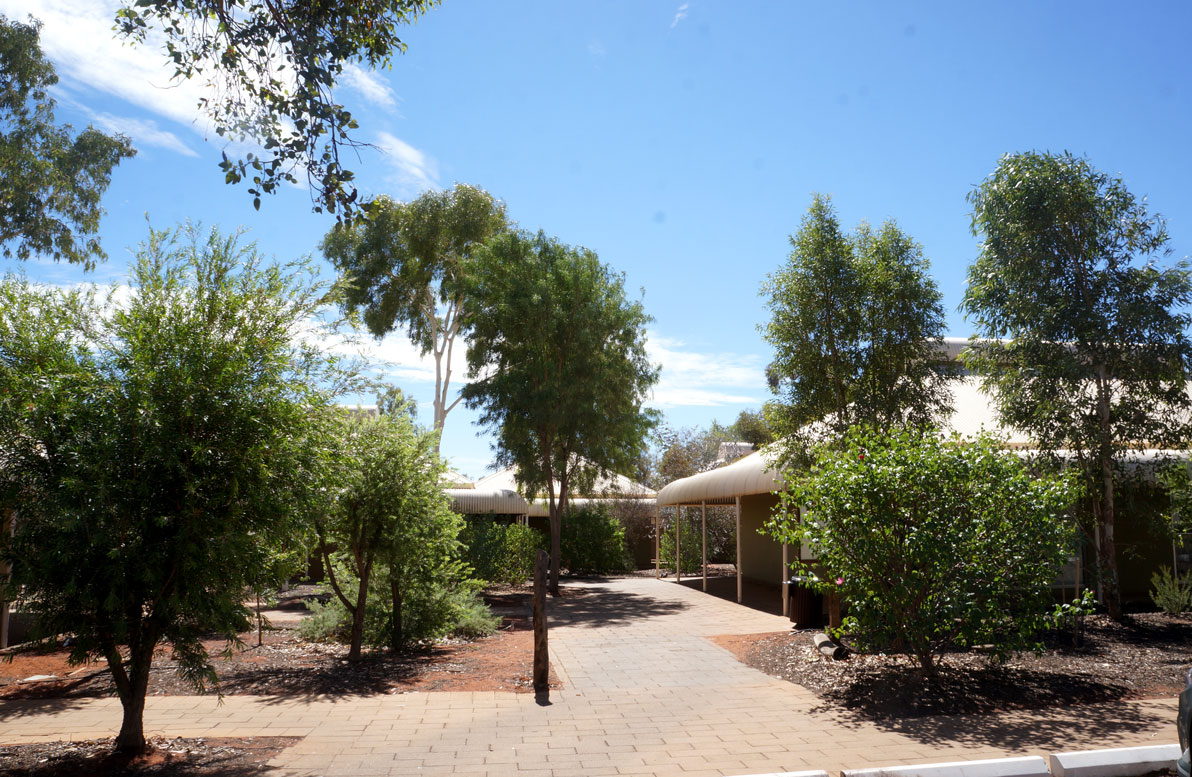
As we were browsing around the tourist shops in the small “mall” in the middle of Yulara, we heard an Aborigine dance performance start in the town square. Four young men, who I would peg to be of mixed ancestry, were putting on a show for the visitors. The songs were based on the movements of animals in the desert and centered around percussion instruments, in a call-and-answer format. The movements were really evocative of the animals they were supposed to represent, and an air of playfulness permeated the dances they chose to show us. The dances are serious business, passed on from Grandfather to Grandson, and with every dance, the boys acknowledged and thanked the grandfather who taught them.
Knowledge gets passed on orally from one generation to the next, and very strictly delineated, from grandfather to grandson, and from grandmother to granddaughter, keeping families close and the knowledge alive. Aborigine stone art are the oldest in the world; in fact, Australia’s Aborigines are the world’s oldest civilization, with over 50,000 years of unbroken cultural expression, living in harmony with the land around them. It is hard to be on this land and not reflect on the incredible sensitivity to nature required to be able to thrive out here. And how that knowledge, that genius, was (and to a good extent continues to be) unappreciated and destroyed.
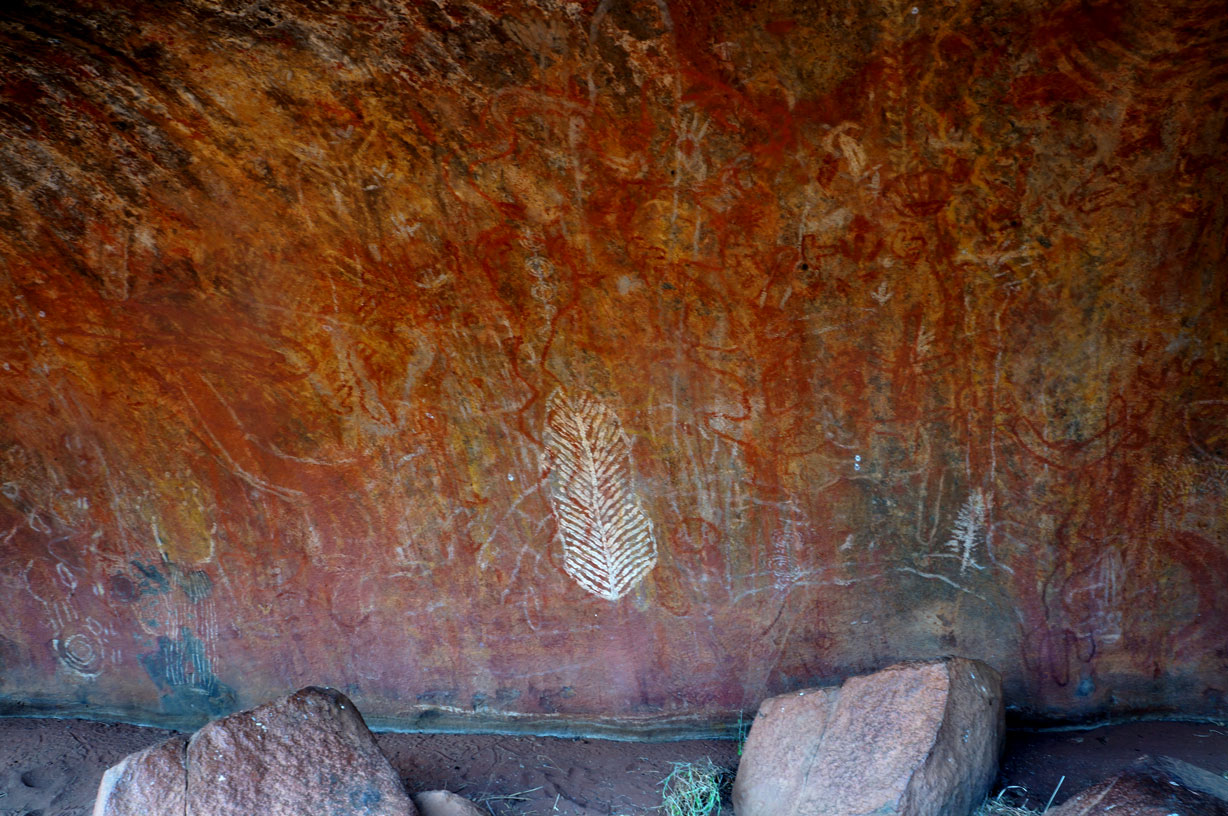
Off on the side of the dancing stage sat four women who were selling beautiful dot-art canvases. I am beginning to develop an ever greater appreciation for the inlaid complexity of the art here. I would look at the composition with very naïve eyes; appreciate the colours and the intricacy of the pointillism, but then have had the little details pointed out to me and what they signify, and suddenly each picture turns into an incredible story, ready for the reading.
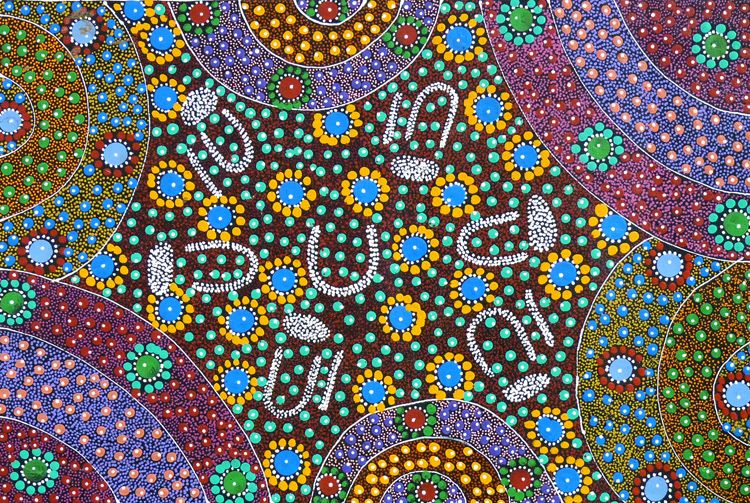
From my online perusals, my favourite artist is Janelle Stockman Napaltjarri. Sadly, she passed away in a car crash in 2009. Her art, however, lives on.
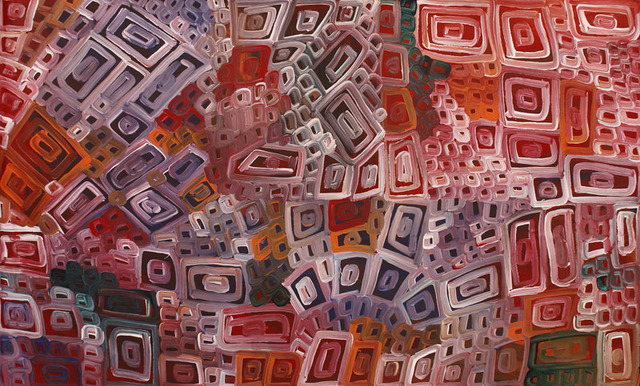
The next day, we got picked up by the tour we had arranged, called Adventure Tours Australia, which breezed in from Alice Springs. The tour guide was a peppy young man by the name of Justin, who was a new recruit, and as cheerful and jolly and cutie-pie as can be. In fact, this was his inaugural tour, and his safari jumpsuit, somewhat reminiscent of the uniforms rangers in Bugs Bunny cartoons would wear, was so fresh and neat that morning (and in fact every morning …now that I think about it, I wonder how he managed it?) and he was so filled with goodwill, that you just wanted to pinch his cheek. We joined 15 other people already on the bus from Alice, and began our Outback three-day adventure.
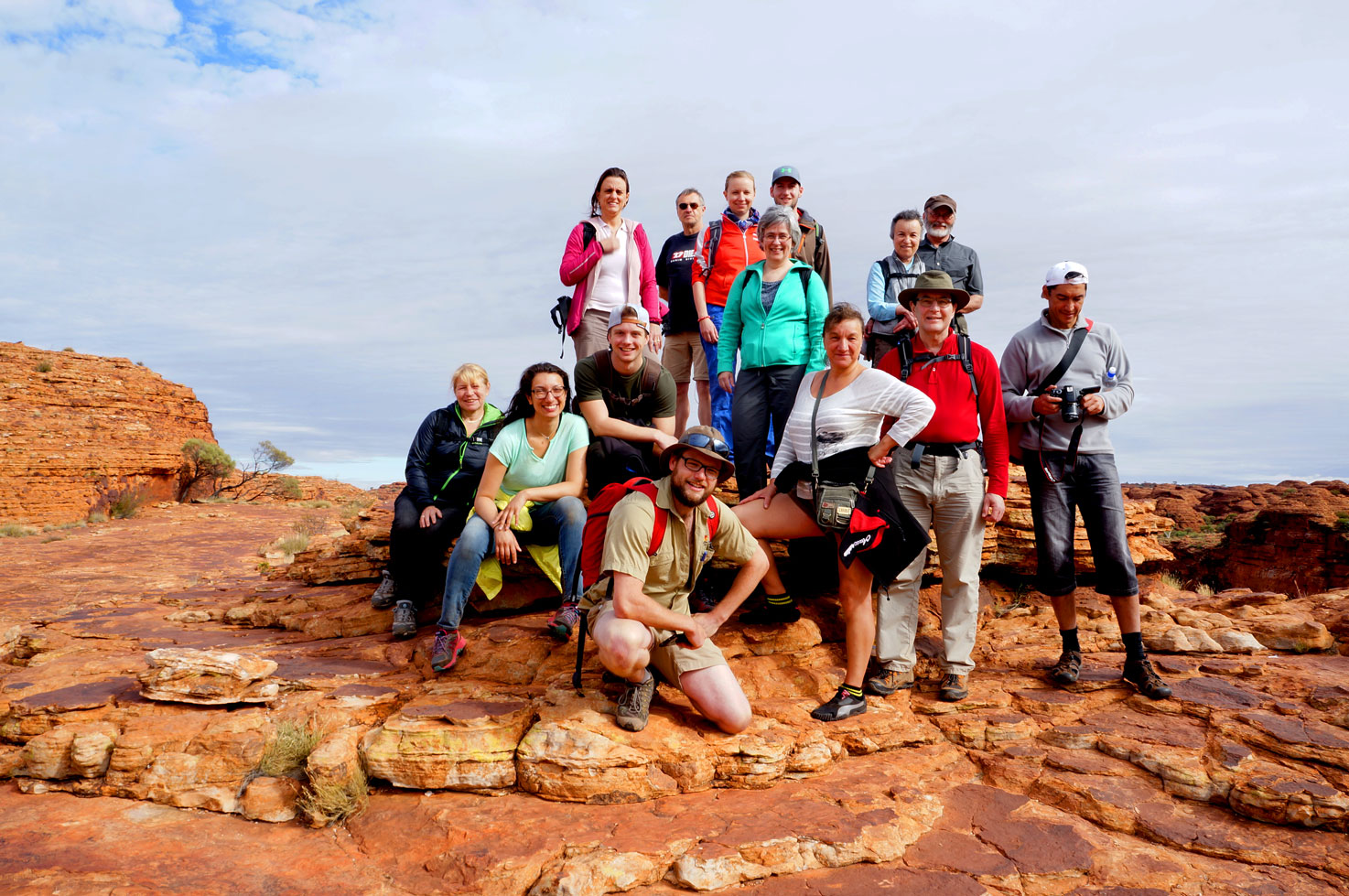
Our first stop was a hike around Kata-Tjuta, a rock formation actually comprised of 36 separate domes. It is about 30 km away from Uluru, and the two sites are the heart of the Uluru-Kata Tjuta National Park: 1,326 sq. km of wilderness belonging to the Anangu people. Both rock formations were formed around 550 million years ago, and both are actually just the top of desert “icebergs” that continue about 6 km underneath the surface of the earth. Both of the monuments glow a deep red at sunrise and sunset, depending on the weather conditions – the minerals in the rock reflect the sun’s rays and cause the glow, but I wouldn’t really know because the spirits at the park must have been having a good go at us, as there were 4 days of solid overcast during sunrise, sunset, and prime star-watching times. But, like clockwork, every time we had to haul our butts back into the tour-bus, the skies would magically clear into a brilliant blue.

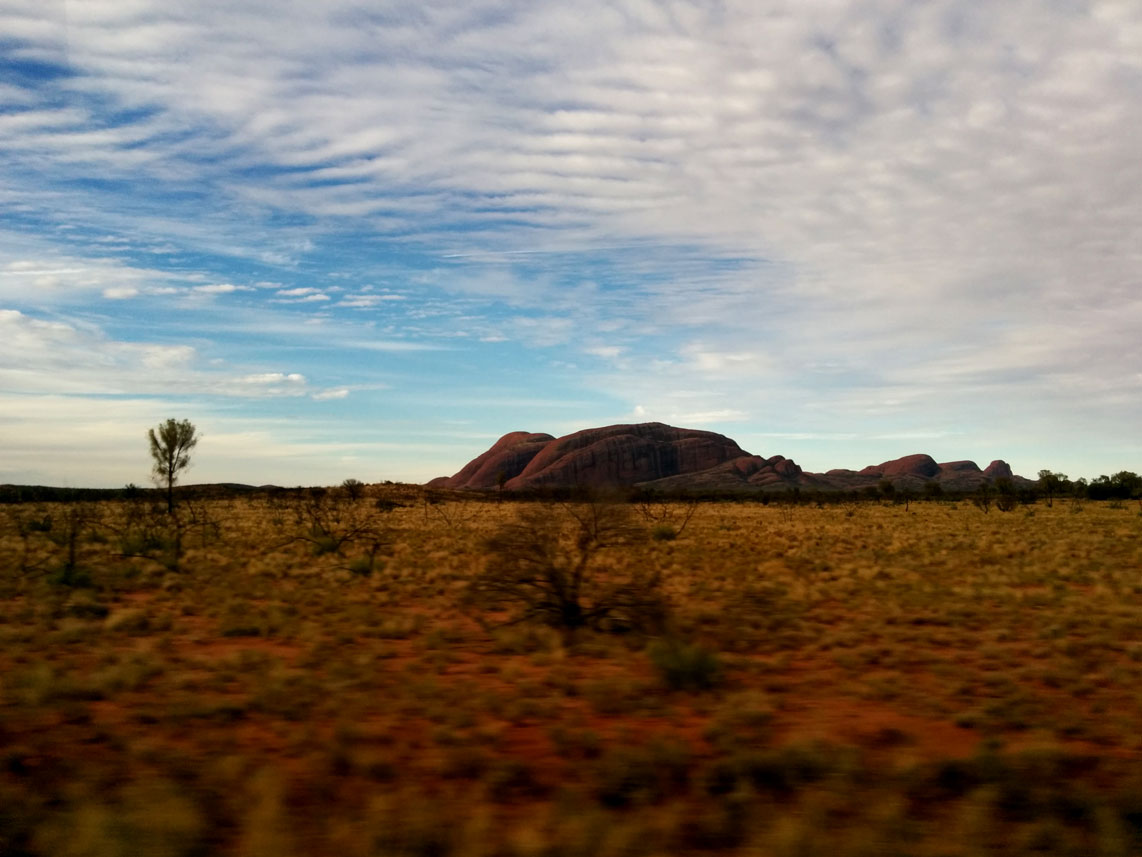


I read somewhere that every time a bird sings for us, or a beautiful flower blooms between the concrete slabs of the city, or you catch the slow, undulating, luxurious expansion of a snail coming out of its shell, it is God’s way of showing his love. Whatever your stance on God, these moments offer us an opportunity for stillness and wonder, of appreciation and joy, where our hearts take in the marvelous beauty of our world and we let gratitude and happiness fill us. I had such a moment, while we were bouncing along in the bus. I glanced up and saw a circular rainbow. The sun seemed like an enormous eye looking down at the landscape through rings of clouds, and surrounding it was a faint but unmistakable rainbow in a perfect circle. I didn’t know such a thing was possible! The clouds created a funnel-like effect, in that they felt closer to the earth and the sun at the other end of a long, glass tunnel.
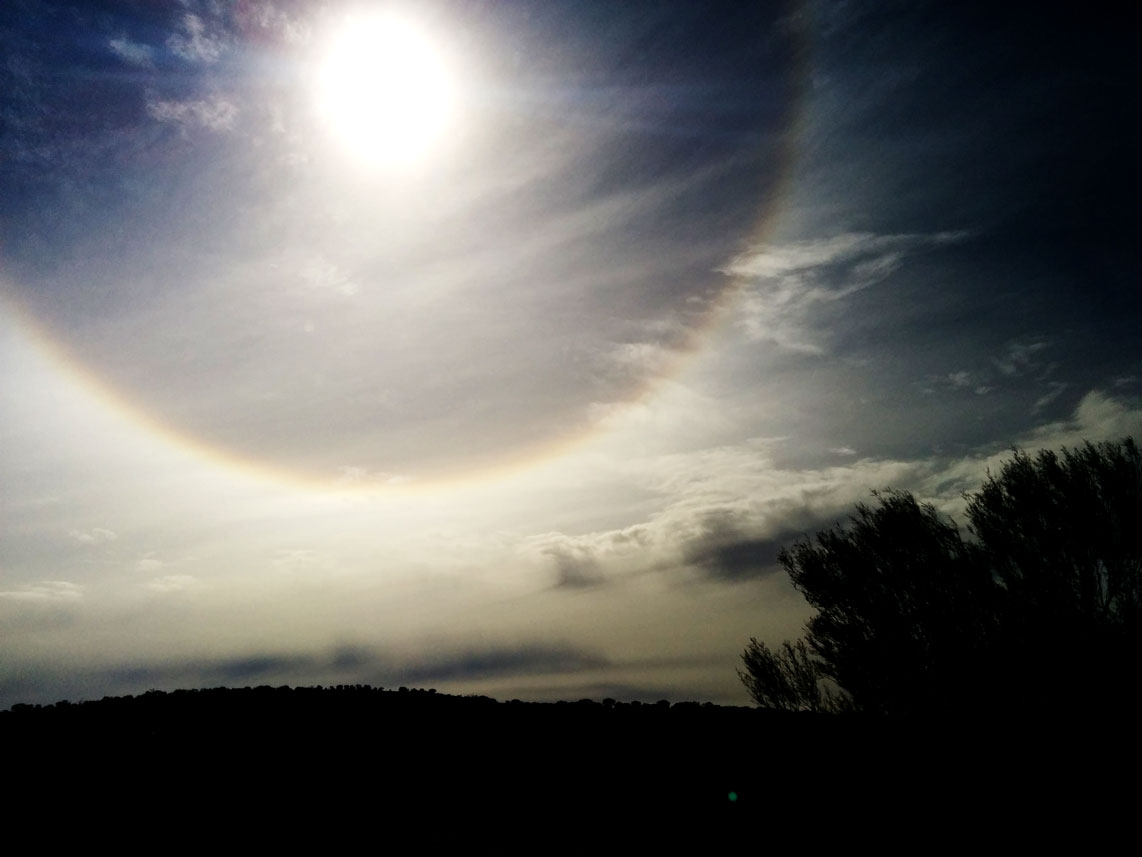
The other magical thing about the domes is that with every angle change, the rock seems to shift. Because of the 36 domes, with every step you take, your perspective changes slightly, and it seems that the whole composition of the rock(s) changes as well. Also, it is massive. The hike we did was only a 2.8 km, 1.5 hour one, but there’s a more involved, 4-hour hike that one can do, and which I dearly wish we could have done. There is a part of the walk that goes through the Valley of the Wind, and, hand-to-god, the wind sings as it sweeps between the domes and along the pathways at the base.
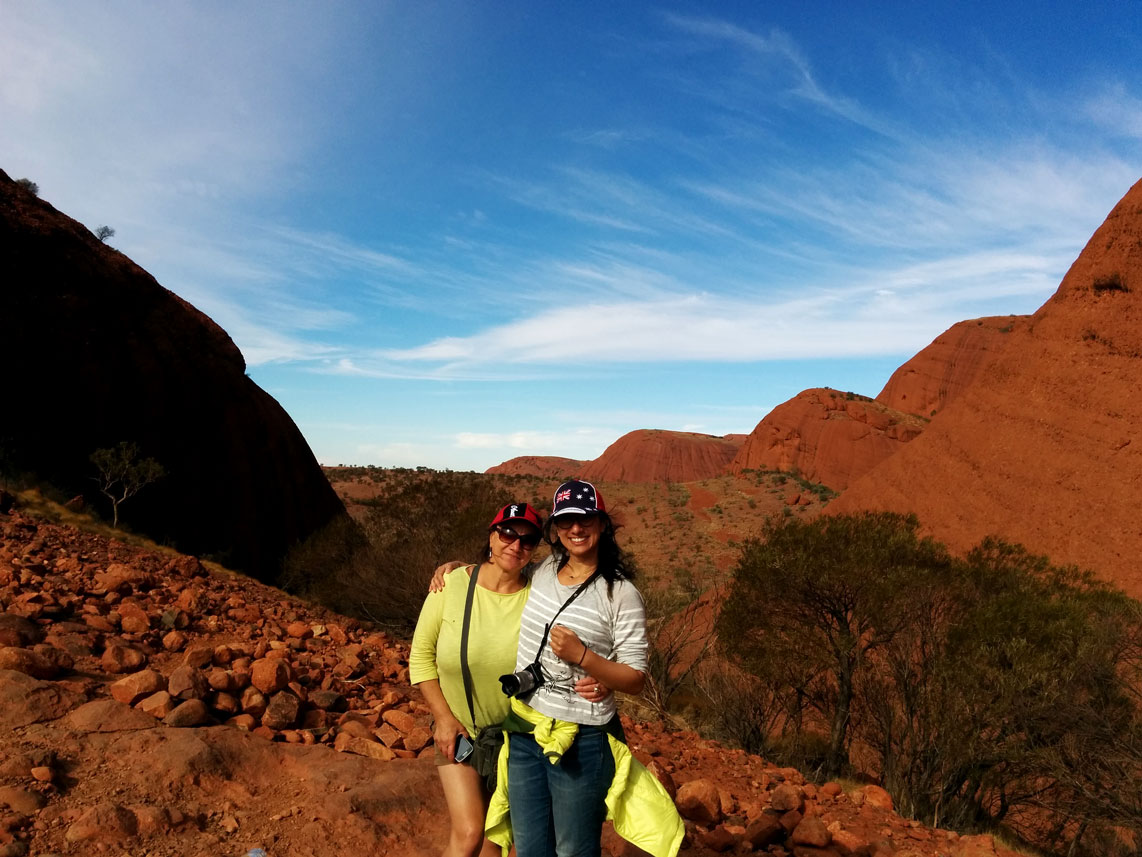

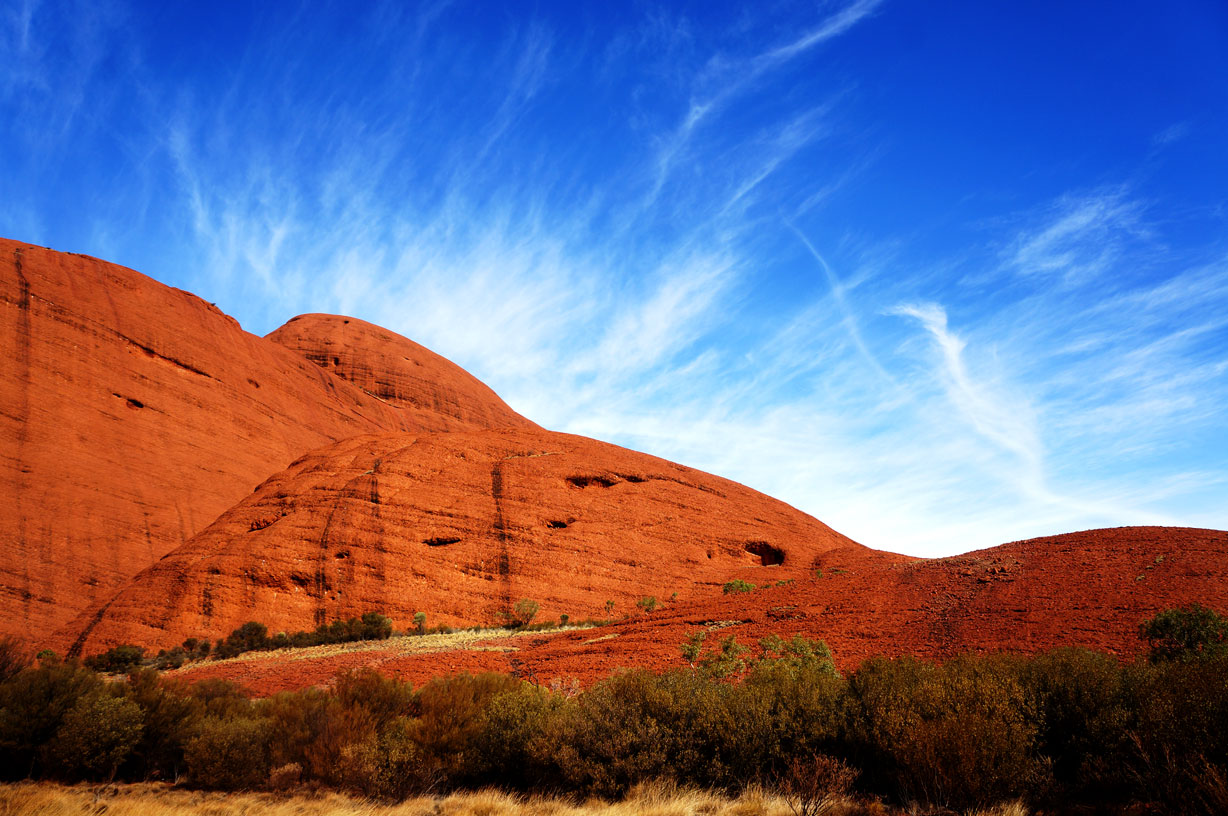
The site is still actively used by the Anangu people for various rituals and ceremonies, and there is a certain aura that radiates from it, perhaps an energy of all the sacred thoughts and actions undertaken at the site. Kata Tjuta is specifically sacred to the men of the community, and women are not allowed to come to it. We had a guided walk around Uluru the next day (The Mala Walk), and the Ranger, who was Aborigine, clarified that some sacred sites were for men only, while others were reserved for the women. While Europeans thought this meant that their societies were strictly patriarchal, he insisted that this was not so. “The European anthropologists and sociologists only bothered speaking to the men,” he told us “so they heard half a story through their own particular world view. We are not a patriarchal society – we believe men and women are equal. We just have very clear division between what is women’s stuff and what is men’s stuff, and we each do our own stuff so that the whole can work. But we do not think men’s stuff is better than the women’s, or more important.”
Asking the right questions and casting a wide net is important if you ever want to arrive at the deeper truth of anything. I learned that.
We spotted a baby snake in the brush on the walk around Kata Tjuta, which was better than finding one when – get this – my mom decided to stick her foot into a scrubby bush while climbing a sand dune to see if it was very dense or not. I nearly had a heart attack – all my Captain Safety instincts were sounding the clang of disaster looming ahead. It’s a well known fact that in the middle of the desert, you don’t stick your foot into bushes, as the things that live in those bushes may take offense at you not taking your shoes off before you enter their home. In fact, don’t stick your extremities (or your intremities) into any space you can’t clearly see into. Don’t stick ‘em in a hole, in a cave, in a pool of water, in a dark room; actually, not even a glass jar. Some things are just better played safe.
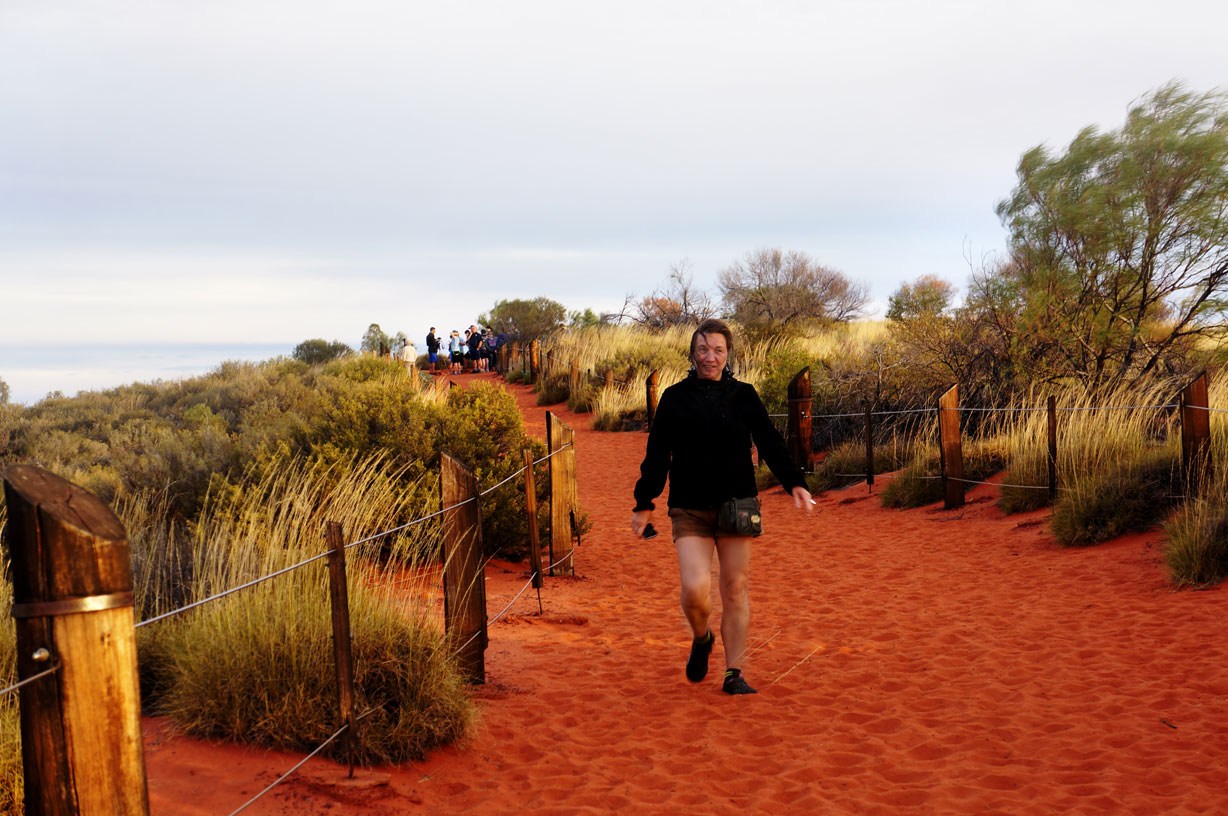

We had to get out of the national park by sundown, as those are the rules of the game, and we drove to a viewing site 25 km away or so, so that we may catch the sunset over Uluru. This was the happening place to be, as there were about 8 other tour busses with their groups already there. Justin set to setting up a picnic table with little crackers and dips and a bottle (or two) of sparkling wine, and we watched the clouds turn beautiful shades of crimson as the sun was setting behind it. Uluru did not glow, but had another, more dusky retirement into night, turning from the deep rust red to a dusky purple and then finally an inky black as the light faded from the horizon.
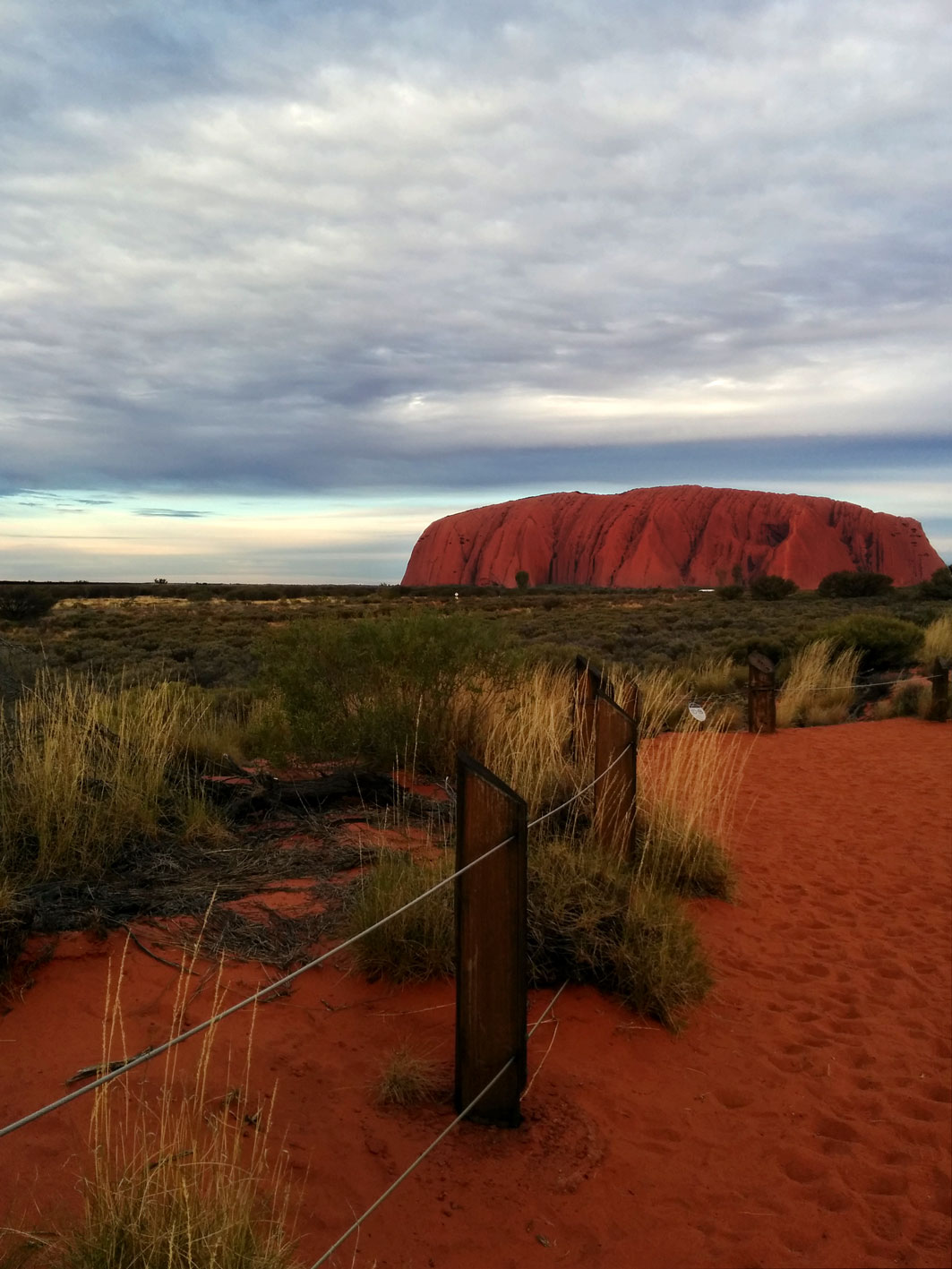
Back in the bus, we knew we were going to our campground where we would be in permanent safari tents, but I originally had thought those tents would be much closer to Uluru, somewhere in the bush. I was a little anxious about exactly how wild we were going to get, but we ended up back at the Pioneer Lodge – or rather, right next to it, at the adjacent campgrounds. Waiting for us was a long, beautifully appointed picnic table, complete with wineglasses, and a BBQ dinner. This, I can get used to. We had a lovely sample platter of kangaroo steaks (rich, full flavour, reminiscent of venison) and camel sausages (think mutton or merguez sausages) and salads to balance out the plate. Considering I already ate croc, I’ve knocked some fairly exotic items off my “to eat” list.
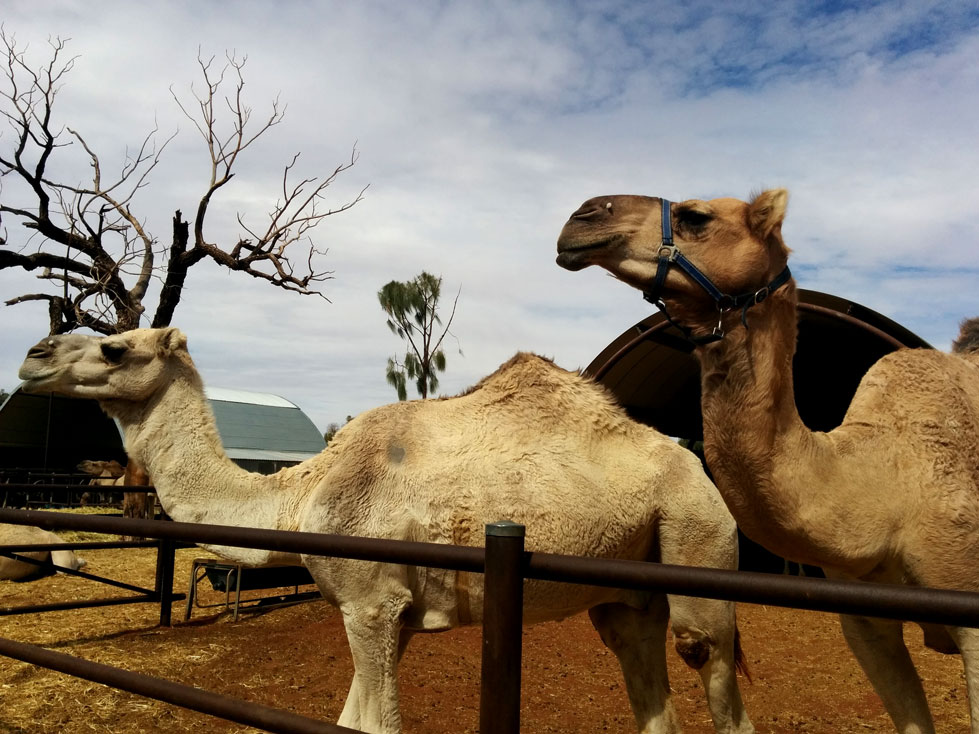
Fun fact: someone told me Australia is the only place that eats its coat-of arms. Other fun fact: Australia’s coat of arms bears the kangaroo and the emu, two animals that cannot take a step backward – much like the Aussie spirit, they can only persevere or pioneer, but they never give up. I like that. (Canada has a lion and a unicorn; neither one lend themselves to ready eating, though I think I’d give the Canada goose and the Beaver a go…).
The next day we went on a hike around Uluru’s base. We were up at 5 am to get in the bus and out to the park before sunrise, and despite – or maybe because of – our little canvas cabin’s simplicity, I slept so soundly and so well that I actually got up at 5 and was ready on time. We arrived about 6:30 in the morning, and began our walk in the charcoal grey light of pre-dawn, which rapidly lit up the clouds in a blaze of glory, but was still much too cloudy for the Rock to glow. Part of the return of the land to the Anangu people was a stipulation allowing visitors to climb Uluru, weather conditions permitting, but the Anangu ask that you please do not, as it is a sacred site and they ask for visitors to respect that. I would have loved to be on the summit, as I think it would be a spectacular feeling, but of course I would never want to tread on someone else’s holy land. I did not feel the same sort of magic at the time here as I did at Kata Tjuta, and I don’t know why that is. Perhaps it was all the other people who were doing the trek with me made it less a private space for reflection and communion for me; or perhaps it is in seeing the whole monolith from a distance that it can speak to me in a way that I can register, rather than being so close to it and overwhelmed by its sheer size and grandeur. It is without a doubt an incredibly special place, and deserves to be called the Heart of Australia.
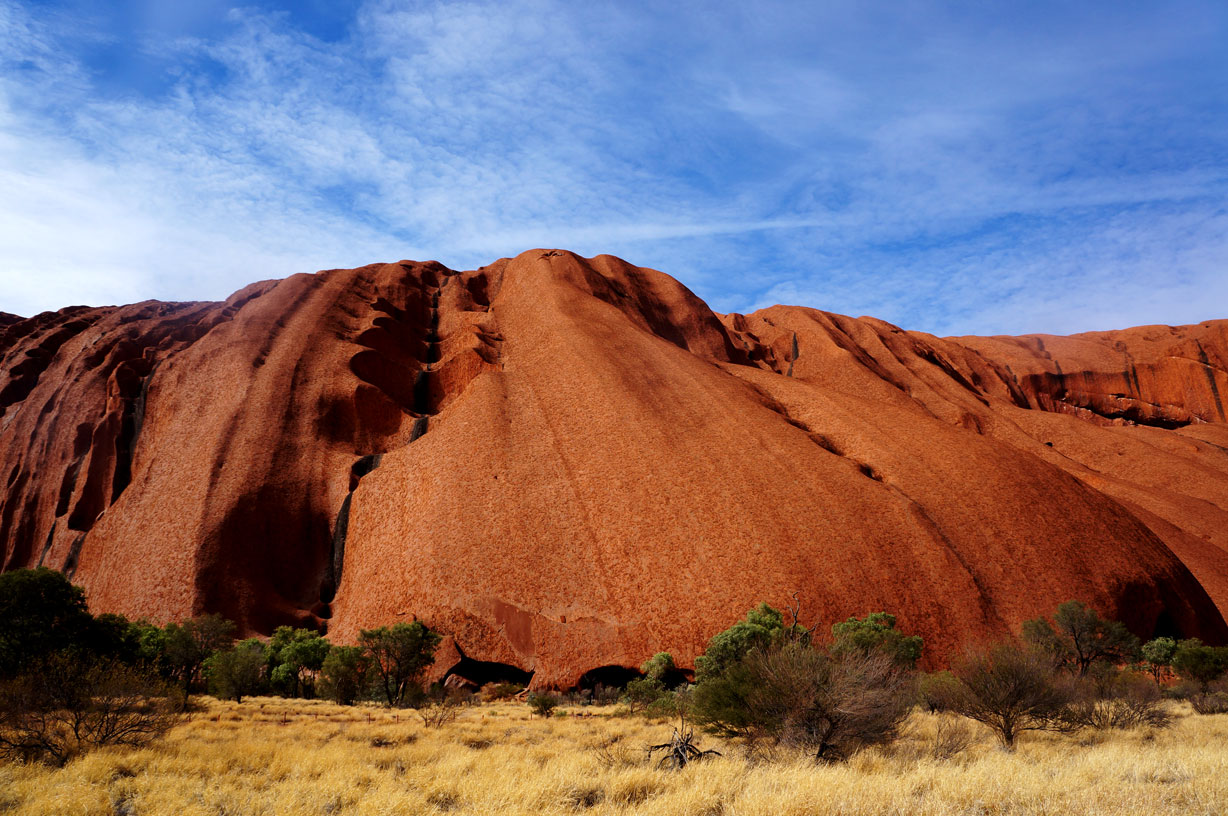
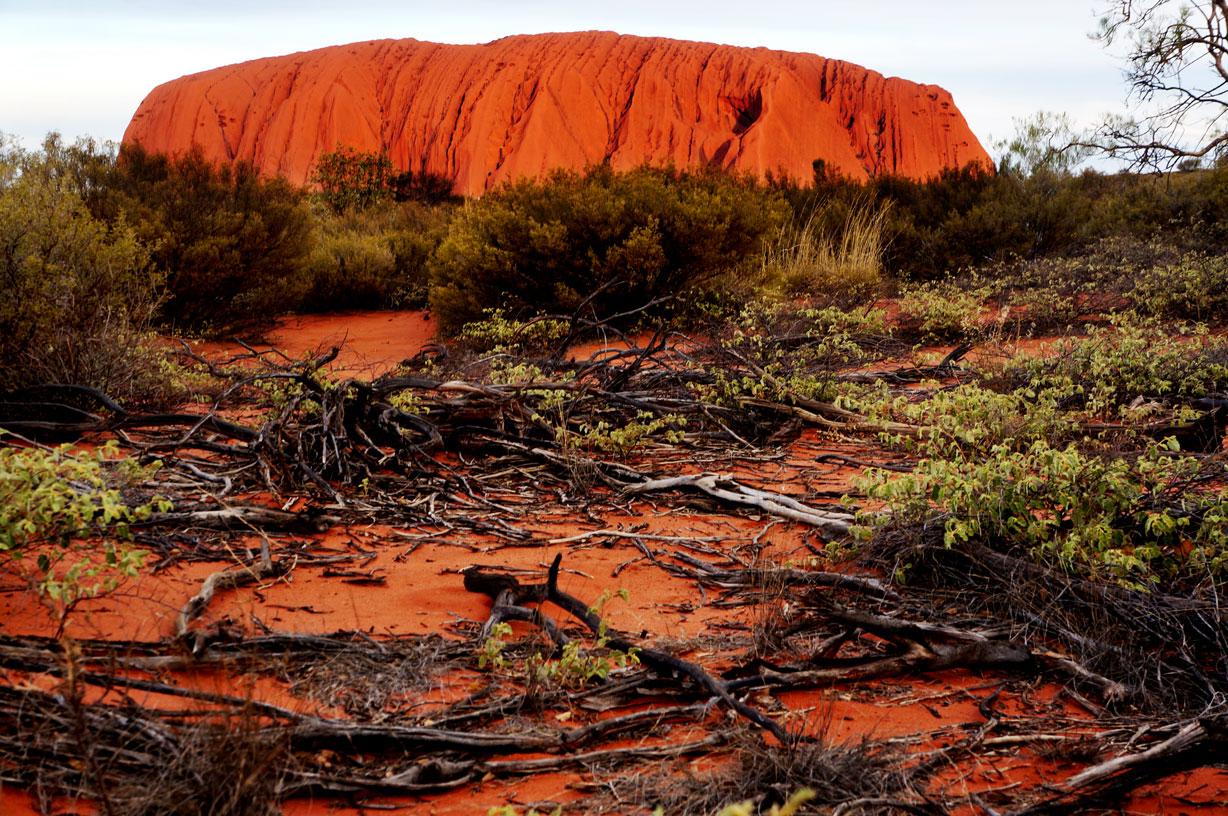

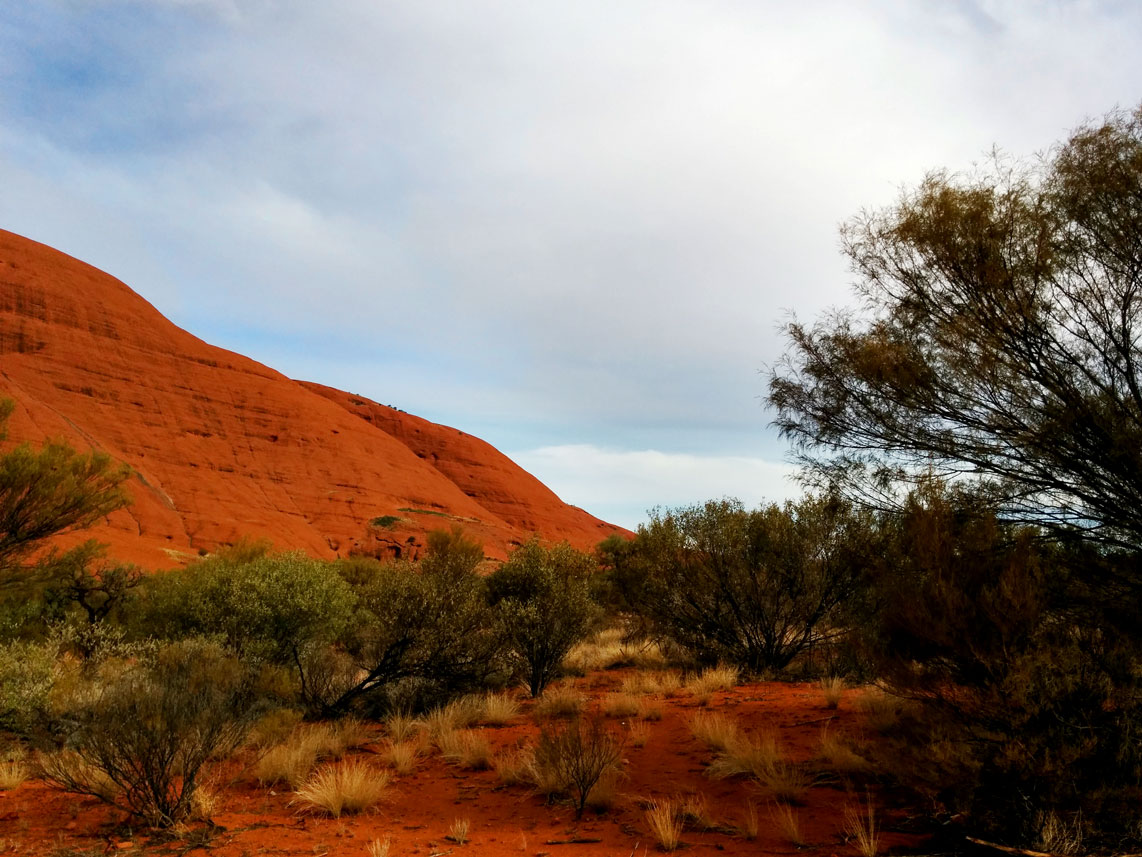
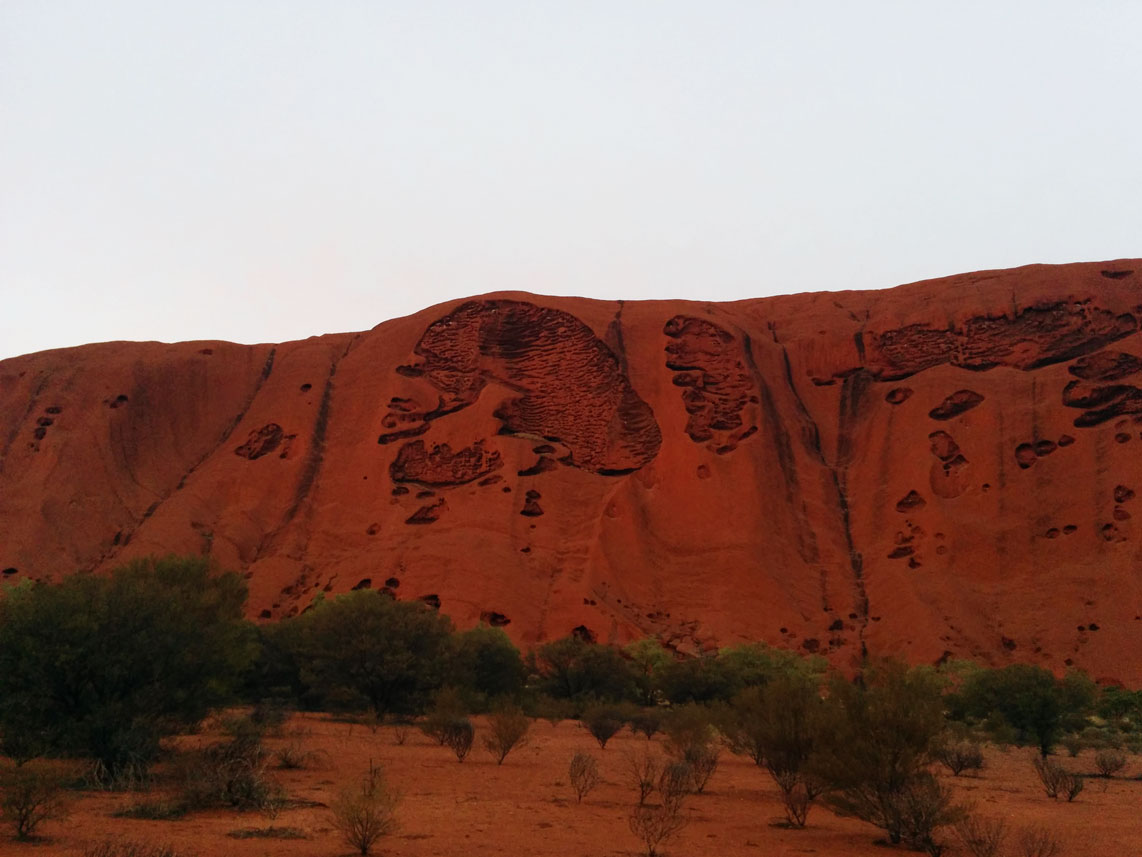
While walking the perimeter, I received another gift: I made a new friend! I was walking and gawking at people (you know, as I do) when I caught a lone traveler’s eye and smiled. He smiled back, and we started chatting. He is visiting from Japan, and had come to Uluru on his own, sans tour, just flew in and rented a car and made the drive over, hinting at a spirit of adventure, so we got along famously. Turns out he is staying in Sydney with a friend for a couple of weeks, and we exchanged contact details, so when I land in Sydney we can meet up. He lives in Tokyo, so I put him on the spot and told him he would have to show me around Tokyo when I get there. This is the part of travel I love the most: making connections, extending goodwill and assistance and getting it extended right back, forging relationships that enrich us and expand our horizons.
We did have another lesson at Uluru during the Mala Walk after we finished the base trek, where we were taught about a host of medicinal herbs that made us look at the “barren” landscape with new eyes, and also learned some very sad things about current government actions that are knocking indigenous communities sideways, including shutting down schools, and cutting off power and water to remote settlements. The government is concerned with costs and with high rates of suicide and substance abuse, but I can’t see how shutting down the communities lessen rates of stress, especially when people don’t want to abandon their homes! I’m not a citizen of this country so I don’t have an MP to ring up and give a piece of my mind to, but I can say that it’s appalling, the degree of ignorance and lack of empathy when creating policy affecting indigenous populations. Incidentally, the Canadian government is going to hear from me on this issue a lot more in the future, because we’re just as bad.
After we completed the base trek and the Mala Walk with the aforementioned ranger, we headed off a further 300 km for the last day’s adventure, hiking around King’s Canyon. Our final day on tour comprised hiking up and doing the Rim Walk at the canyon, which is walking the perimeter of the gorge in a 6 km loop. The canyon can be treacherous though, as it is fairly brittle sandstone, and more than one tourist plummeted to their death when they stood right at the edge, not realizing they were on a precarious overhang. We kept our distance from the lip of the canyon, feasted our eyes on the marvelous vistas of the Outback. Or, as one of our group put it, “Look! Miles and miles of miles and miles!”

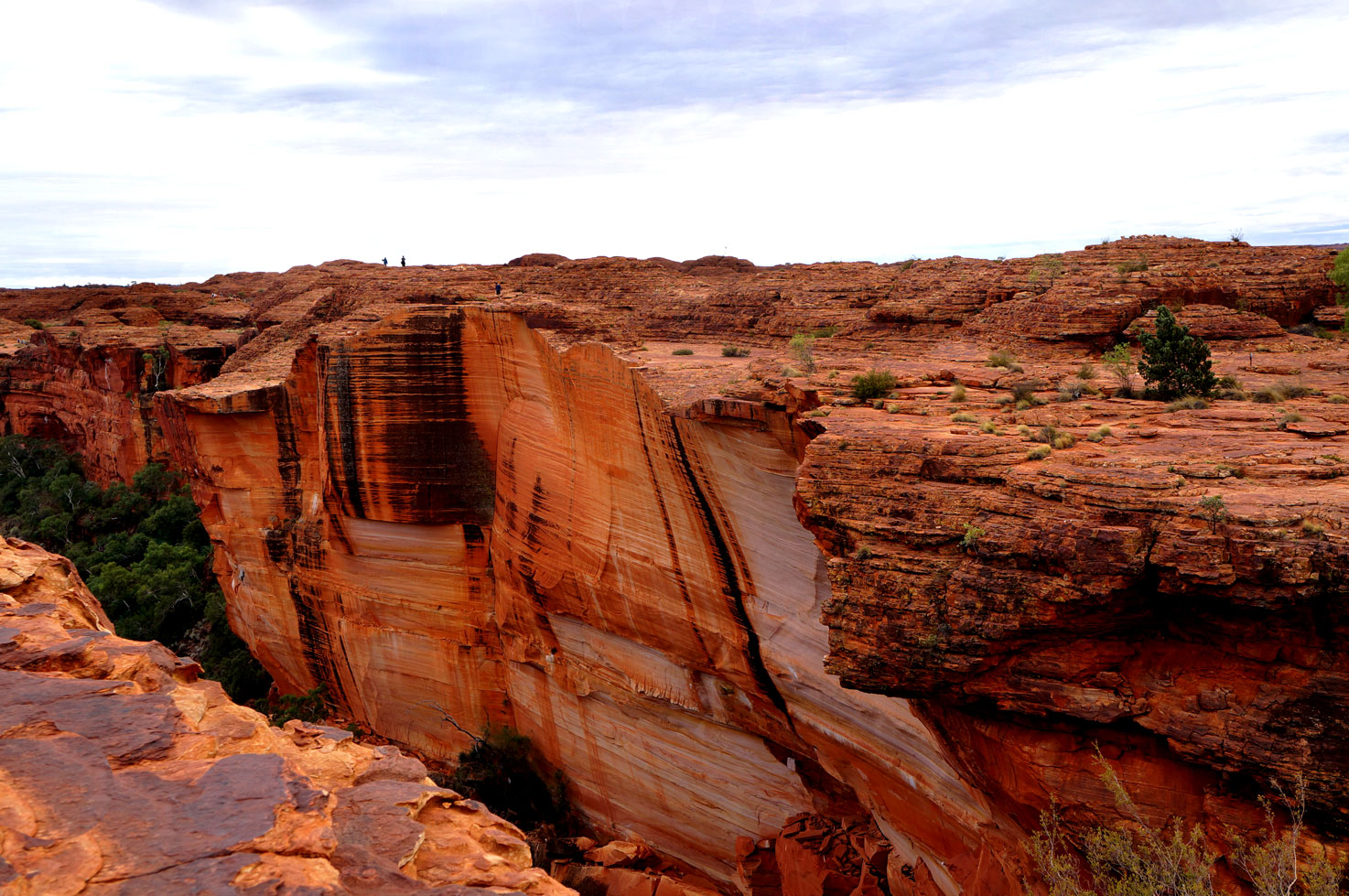
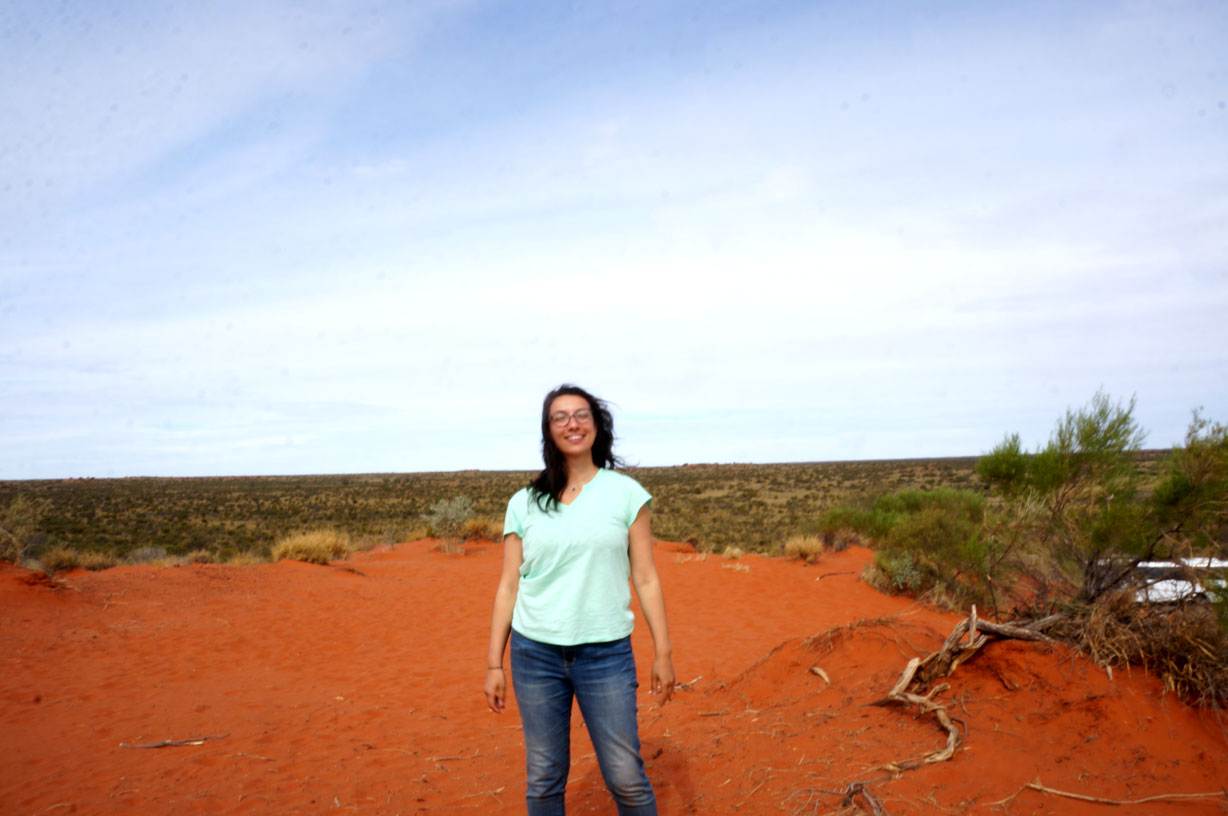
Speaking of our fellow tourists, what a lovely bunch! We had a lovely, retired French financier with us, and I spoke more French in three days than I have in the last five years; a wonderful retired couple from the States – he is a geologist, and was a fount of information all along the trip; a lovely young German couple who loaned us their spare flashlight when I realized I brought my headlamp but forgot the batteries; a young man and his aunt from Austria, and the two us became buds along the trip; and a Russian gentleman who seemed reserved at the outset (and whom I had to remind to smile in photos) but as he warmed up, was a charming, engaging man with a wonderful smile! I owe him panoramic photos, as I promised him I would. There were a few others as well, but though they were friendly, they were not terribly chatty so they kept to themselves.
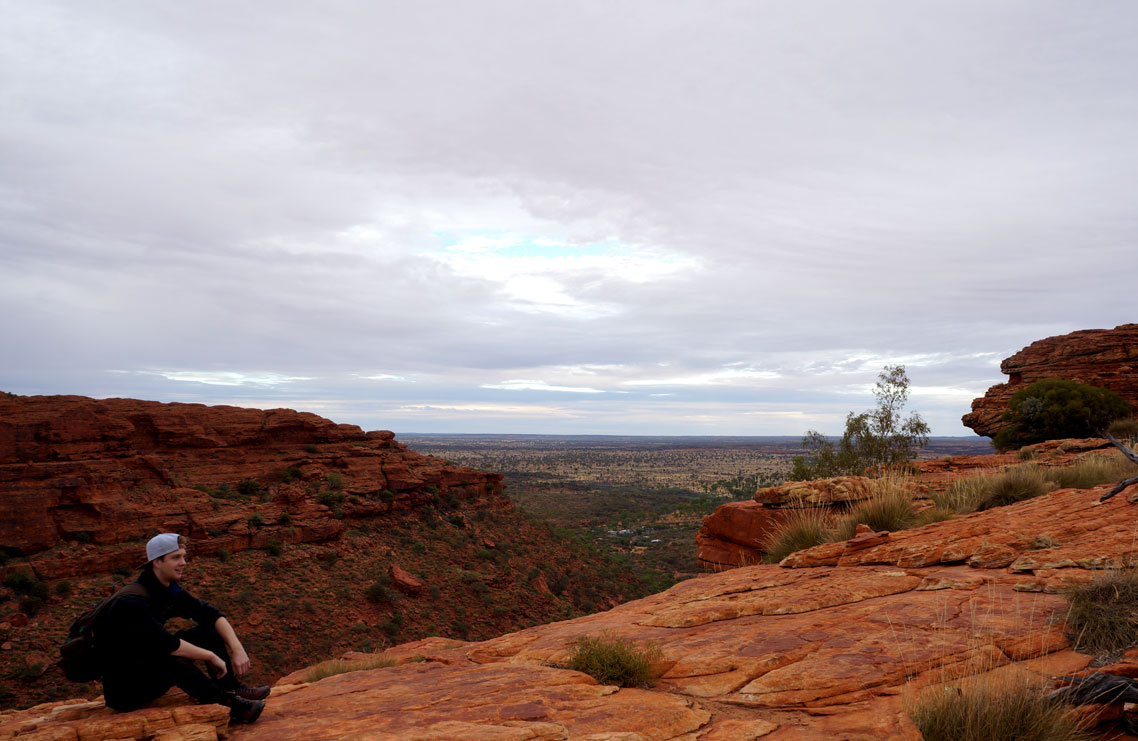
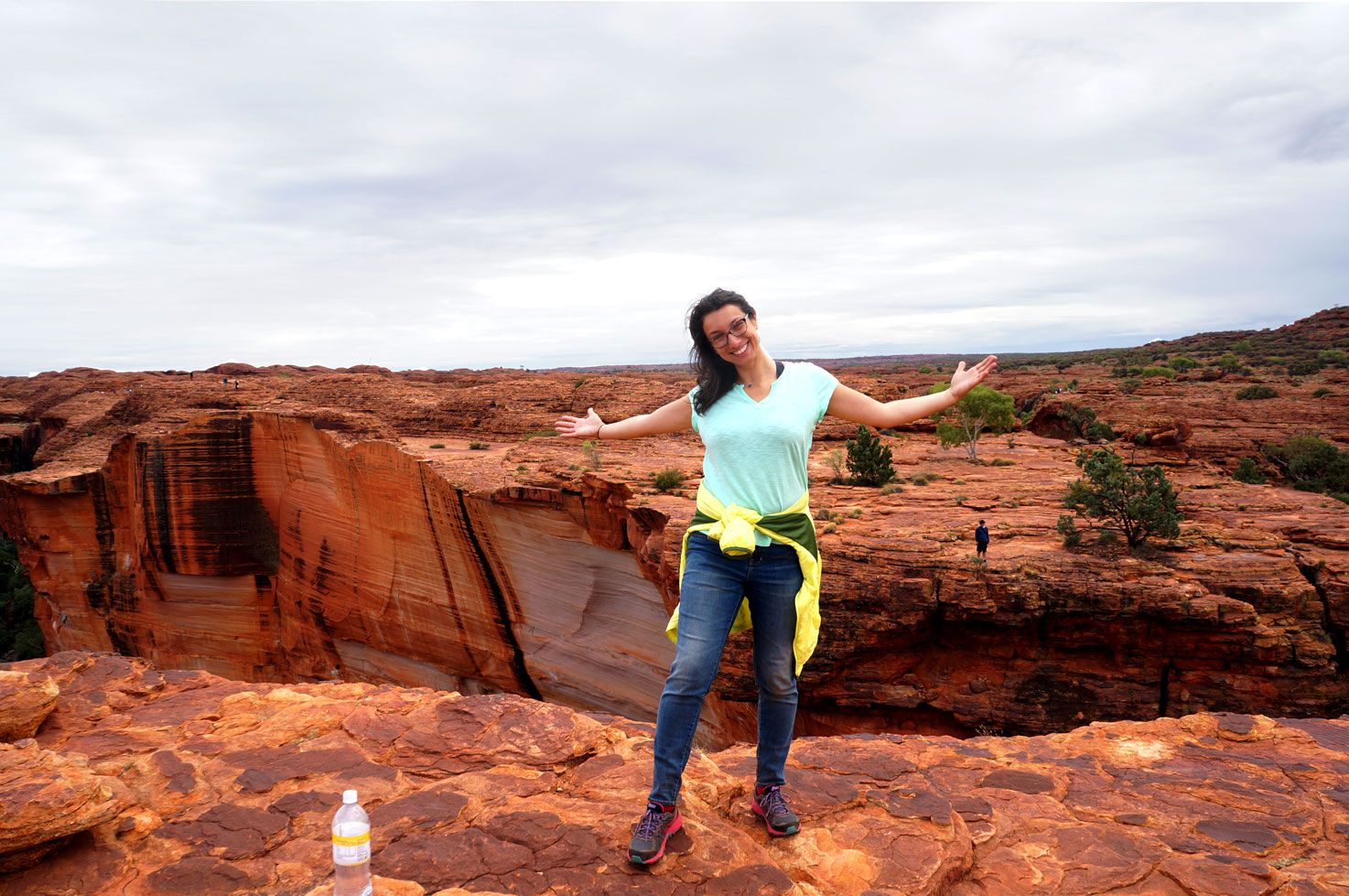
It’s funny how a gorge in the middle of nowhere is a place of abundant life. There is a permanent pool of water in the middle of the canyon, and it looks like a tropical rainforest contained in the sheltering arms of the cliffs. It’s called the Garden of Eden, and for many animals it certainly is. It was a wonderful morning spent marvelling at the dichotomy of the land, and a gentle way to wrap up our adventure.
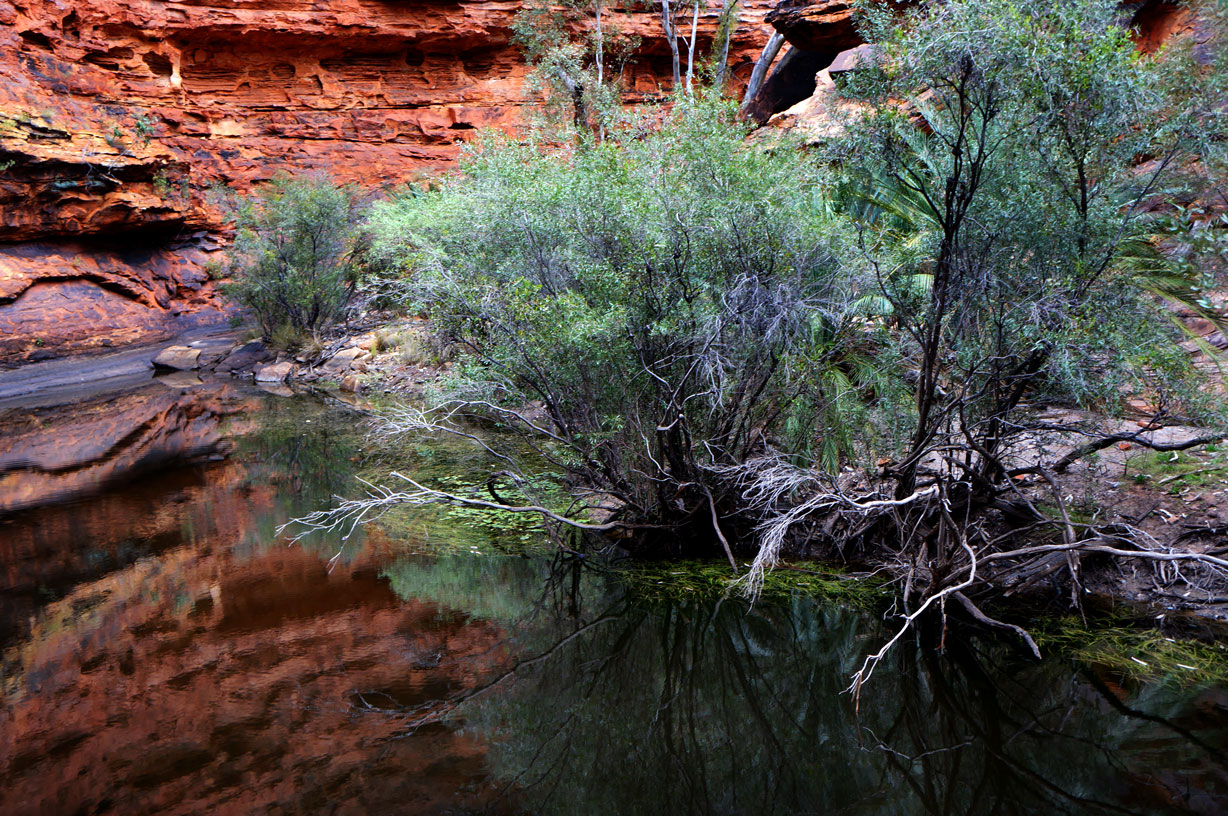
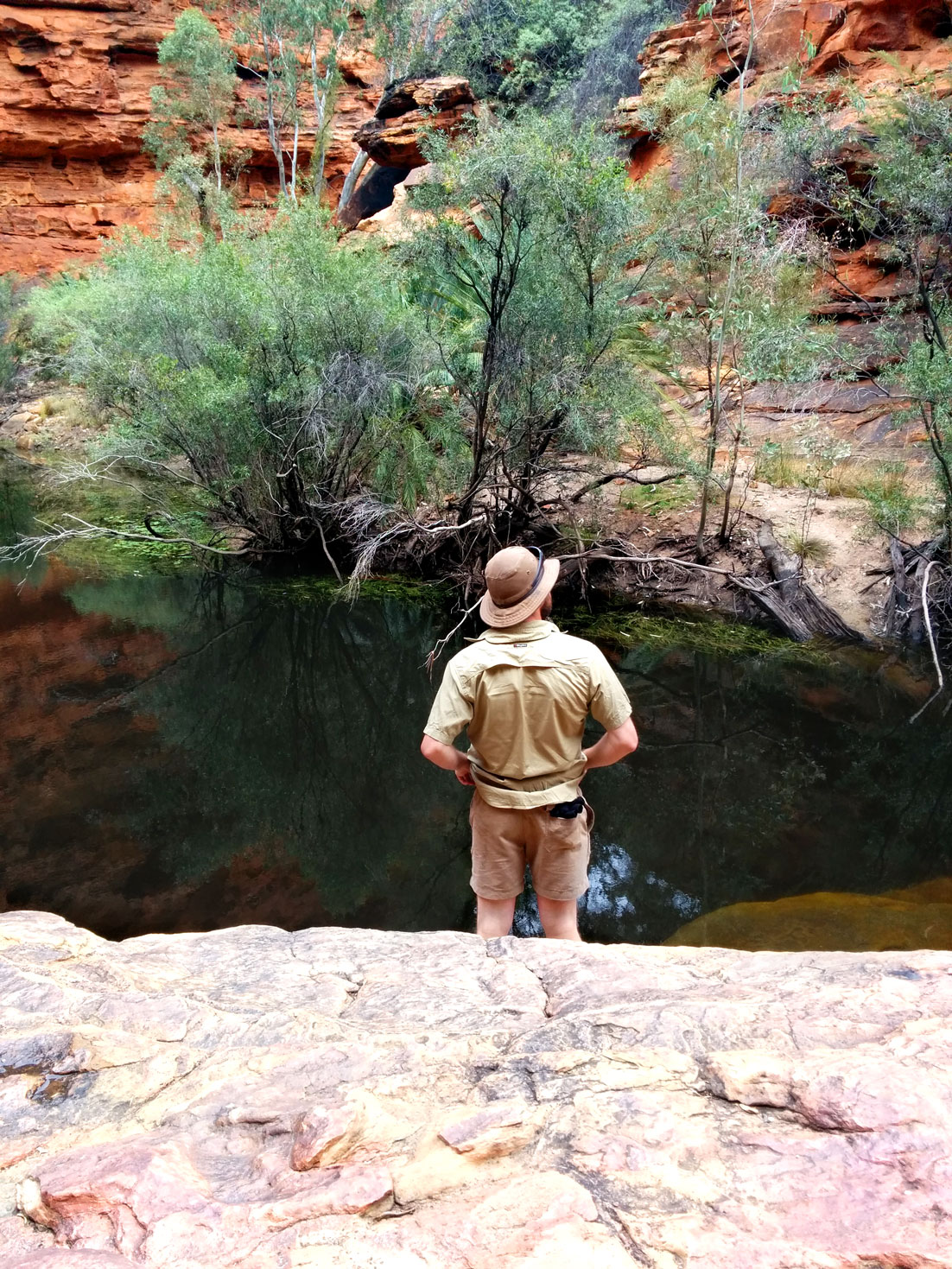
The afternoon saw us on the bus for a good 4 hours on the way to Alice Springs, a town of 30,000 that in the glow of the setting sun, looked inviting and warm. In fact, you have to drive through the crags of the MacDonnell Ranges, and it gives one an epic feeling, like that shot in Lord of the Rings, when Frodo steers the canoe between the rock sentinels. The other side of Alice has the Todd River, which is dry more often than not, and boasts the only annual boat race that got cancelled one year because the river actually had water in it! We only overnighted here, which is a crying shame, because I would love to spend more time exploring this town and the surrounds. In fact, next on the bucket list, is to do the drive from Adelaide to Darwin, and make a nice long pit stop in Alice. And with that, the adventure came to an end, as the next day (and another 5 am alarm), we were headed back to Yulara and our flights back to the urban glitz and glamour of Sydney.
Looking back, I can say I was a little underwhelmed when I first arrived, as I expected something overwhelming and awe-striking when I first saw Uluru. But as I write this, two weeks later, I realize how the power of the region has gently seeped into me, like rain into the ground, and fused its magic into me, for only now do I awaken to the awe within my heart. Uluru sits quietly in the back of my mind, a silent yet unmistakable presence, a sort of backbone that does not and has no need to bend. It was Kata Tjuta that I think impressed me with a more personal presence, more engaged, more immediate. Taken together or apart, the energy of the sacred sites, and the energy of the wilderness around it, have affected me, and continue to work its magic on me. I know I will return here, perhaps sooner rather than later. It speaks to me, in a weird way that I can’t really articulate. But in the red sand and green brush and blackened tree stumps, I have found a part of home.
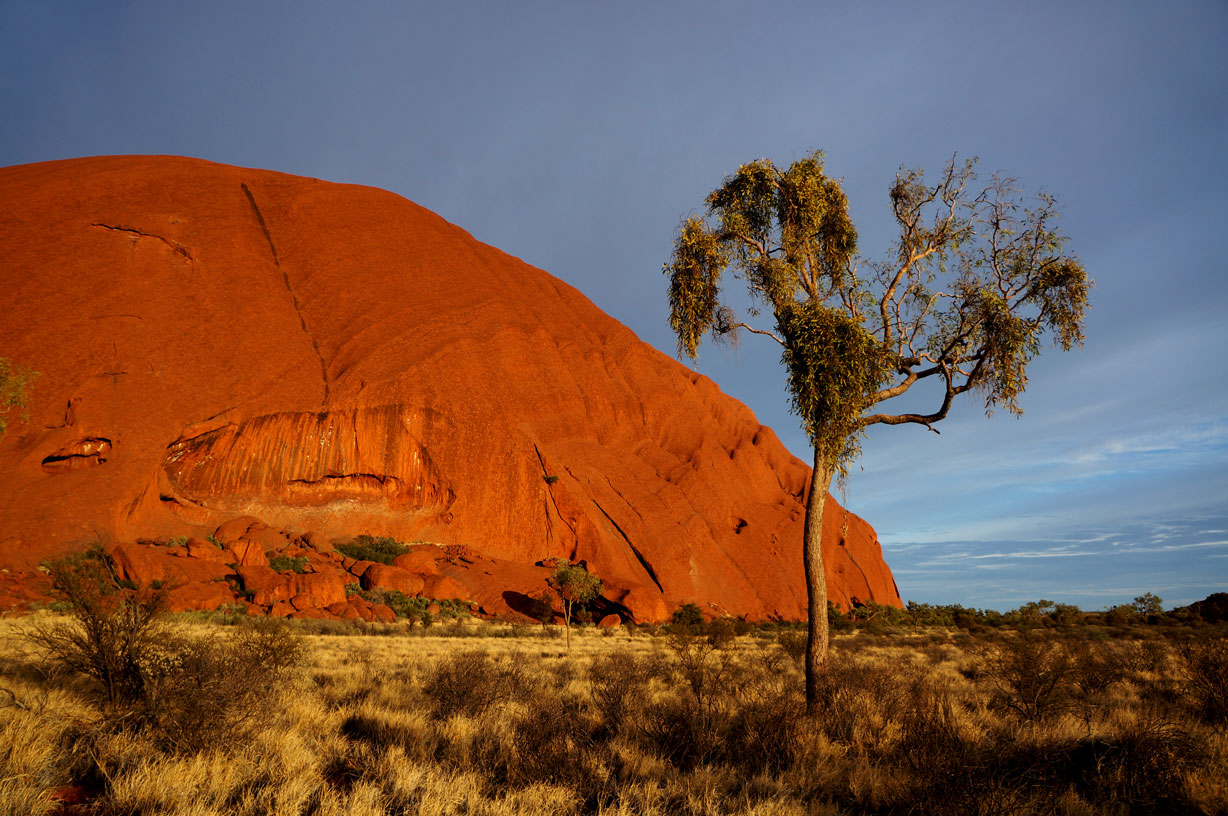
….
Other odds and ends in the Outback:

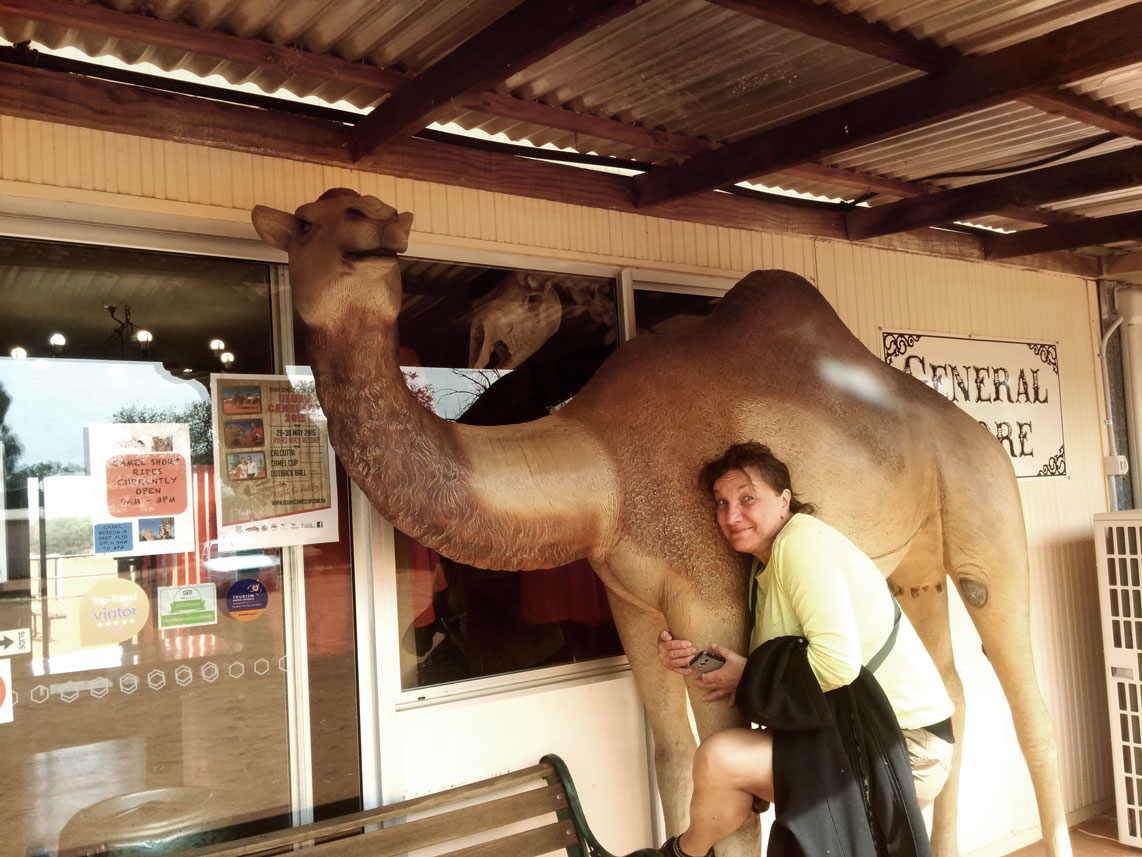

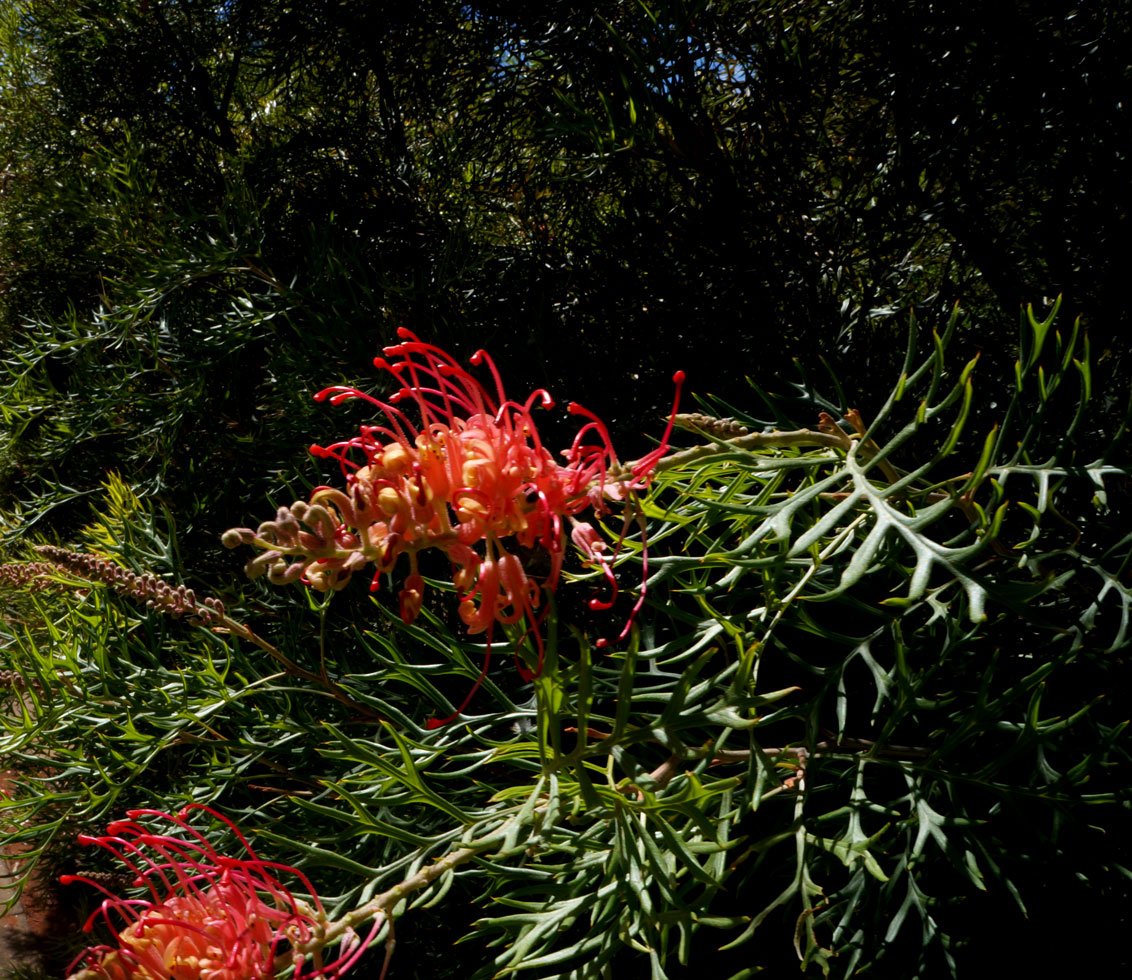
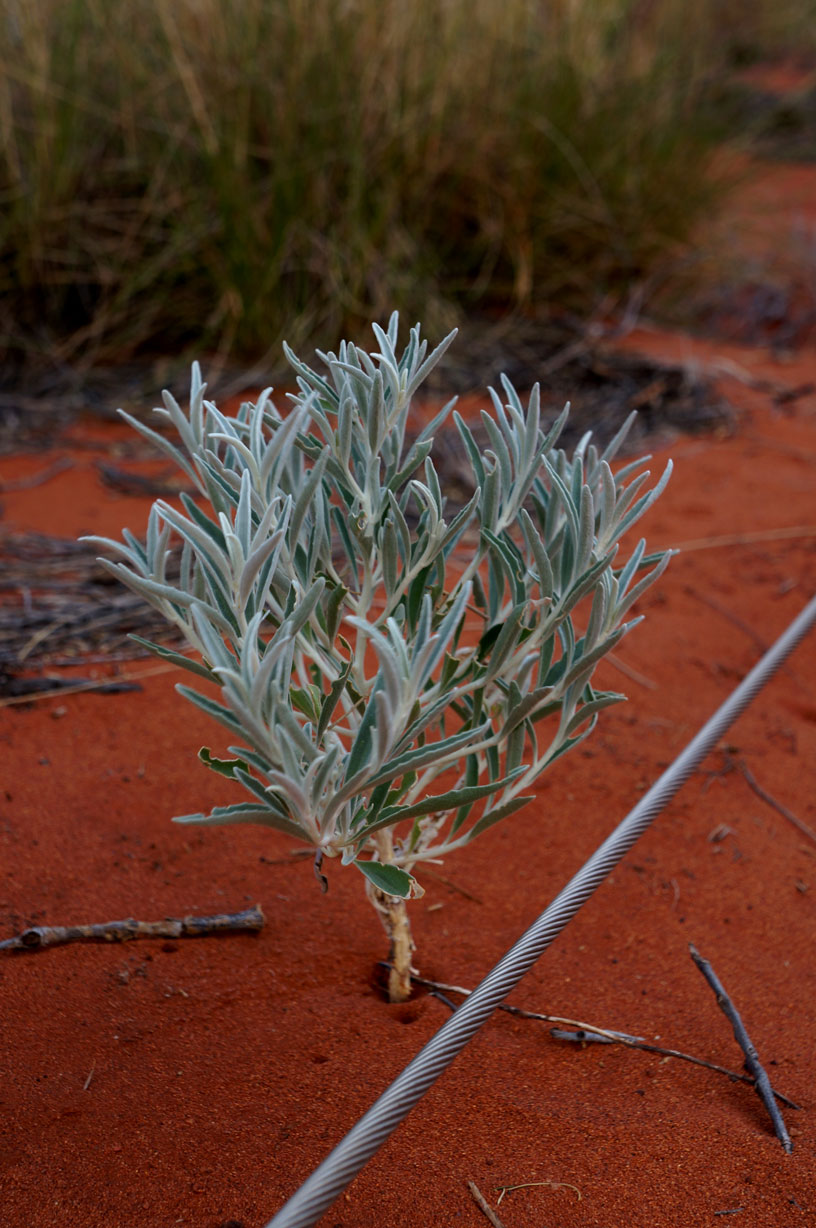
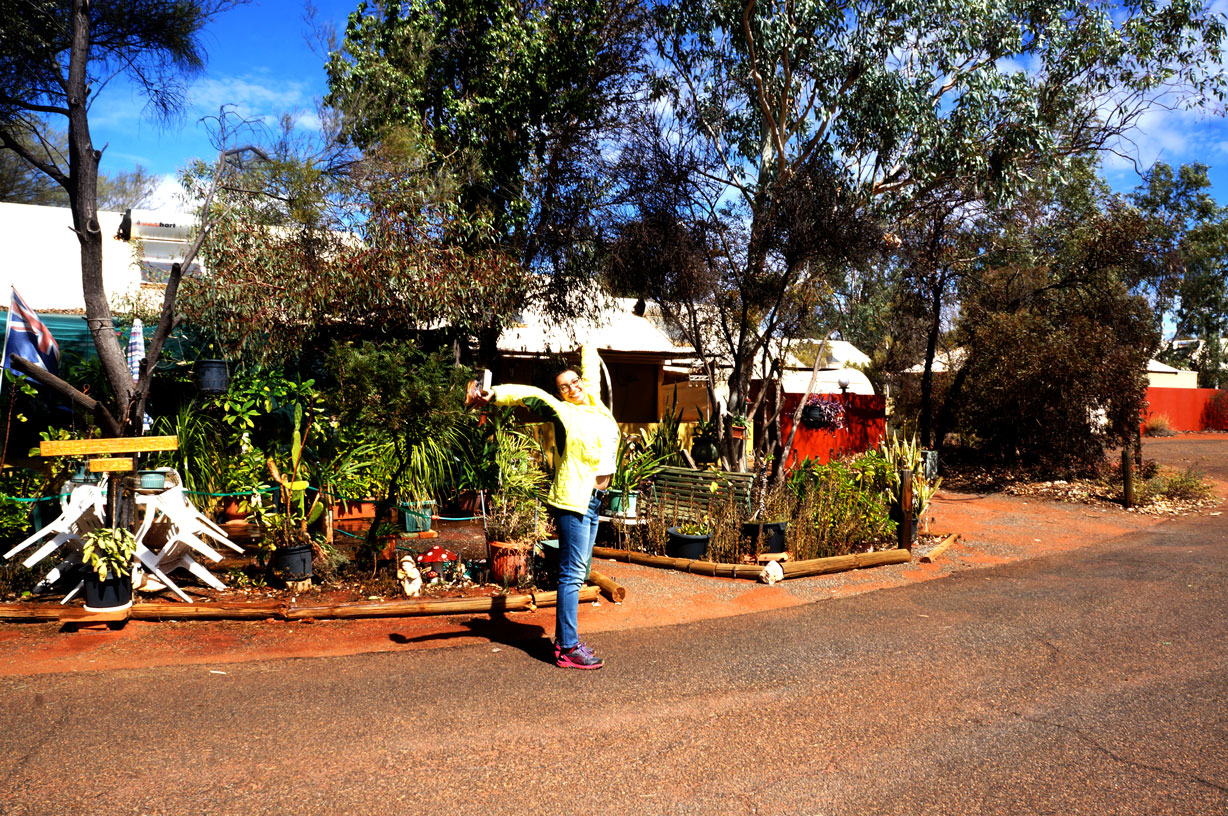

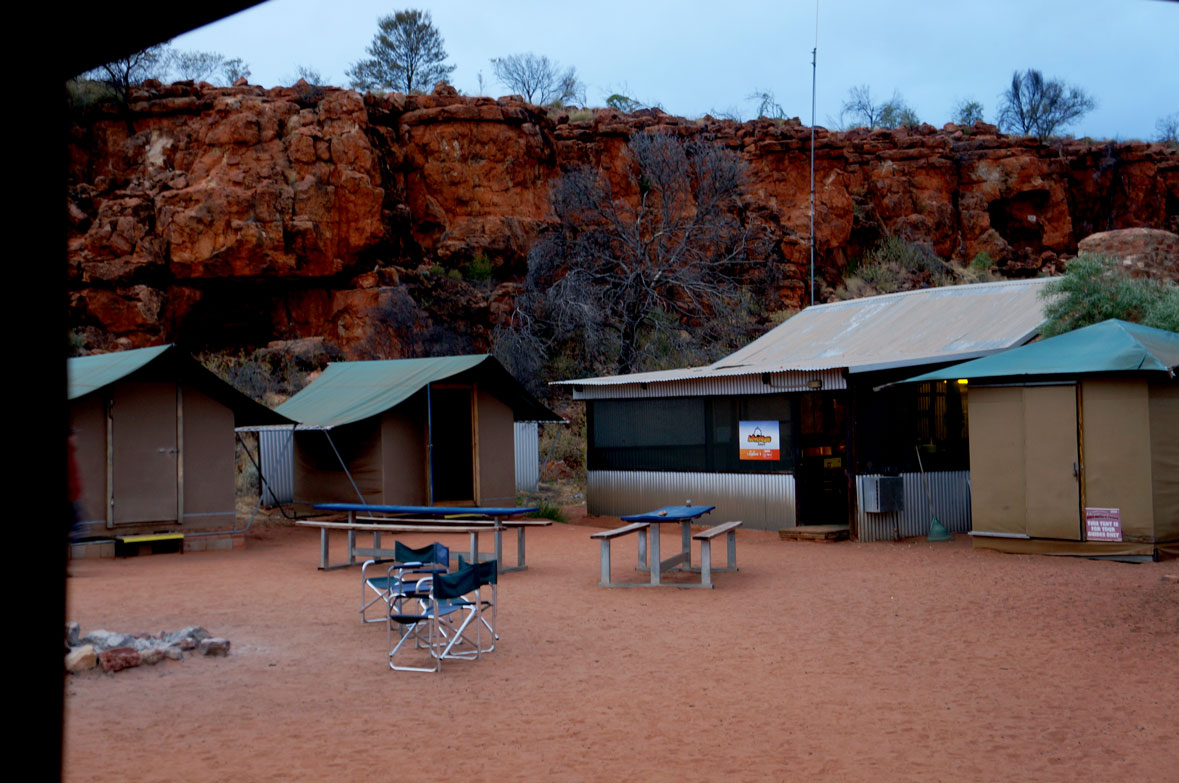
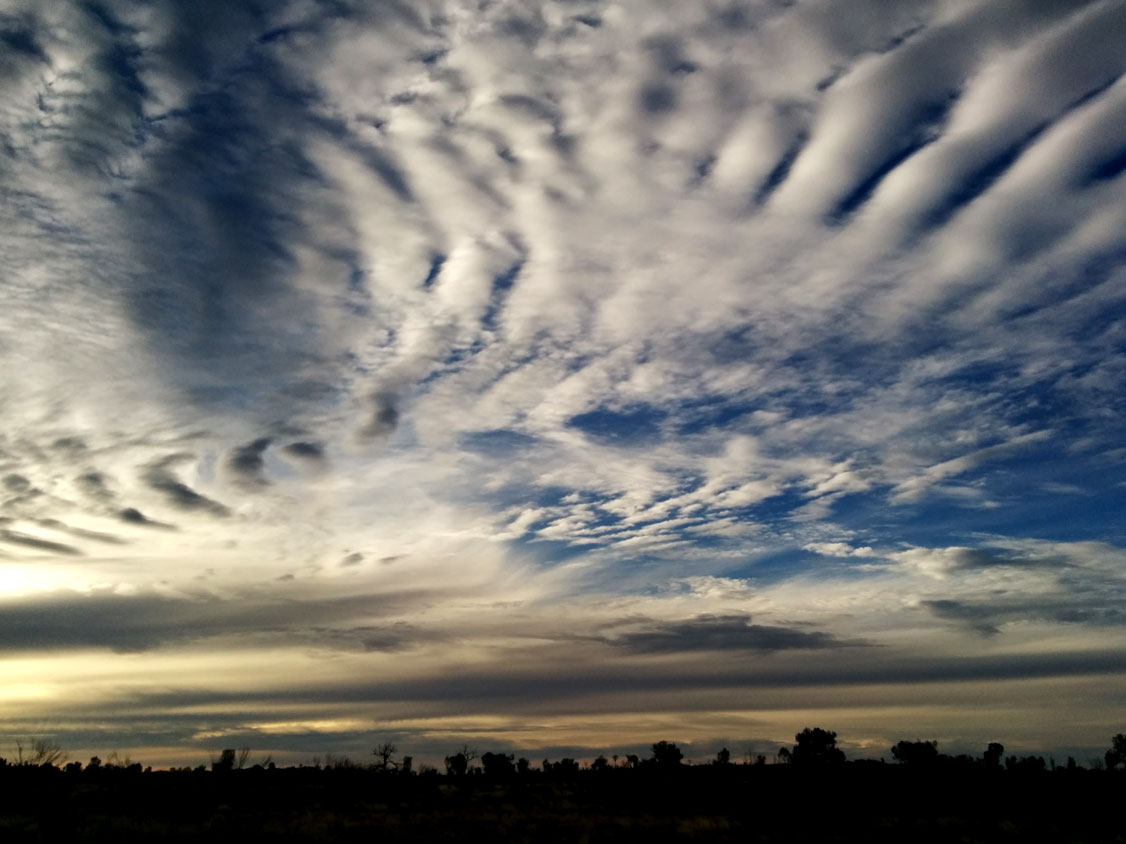
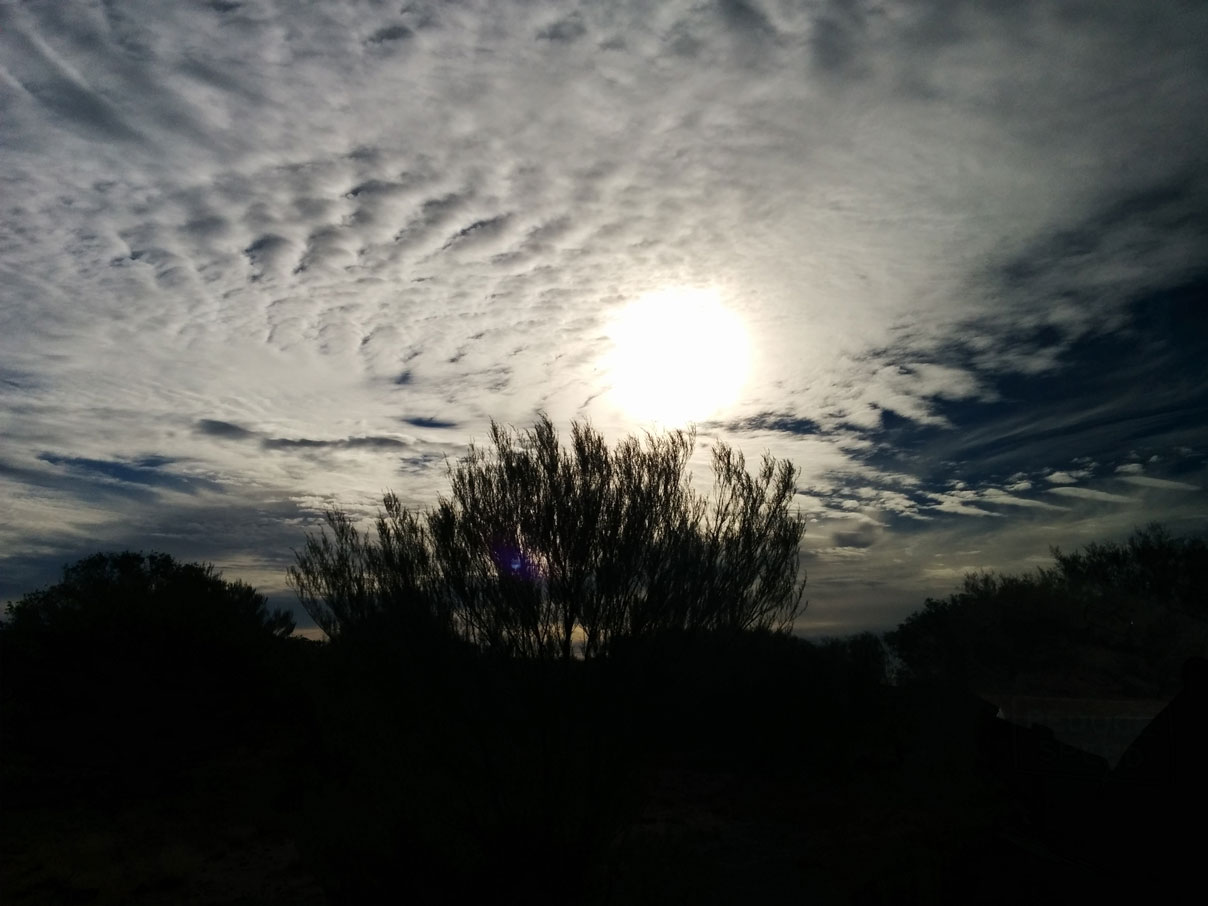
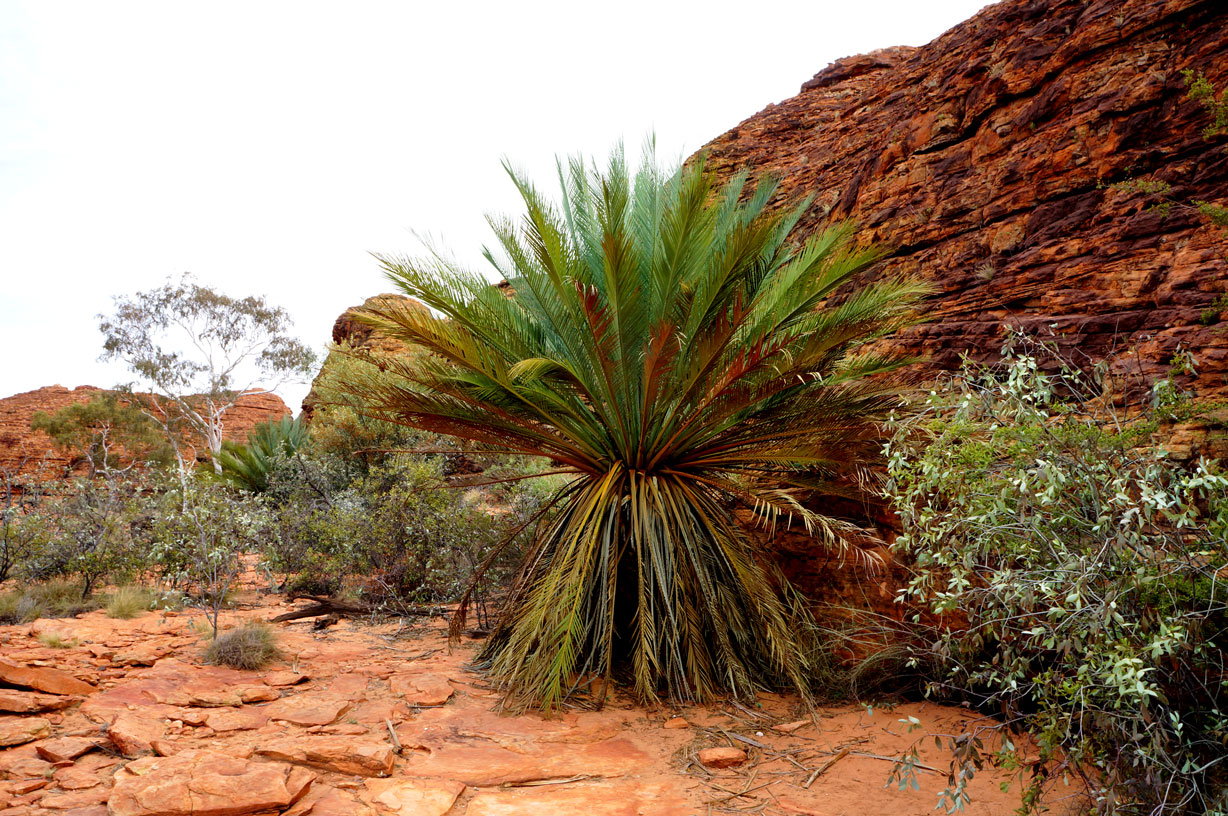
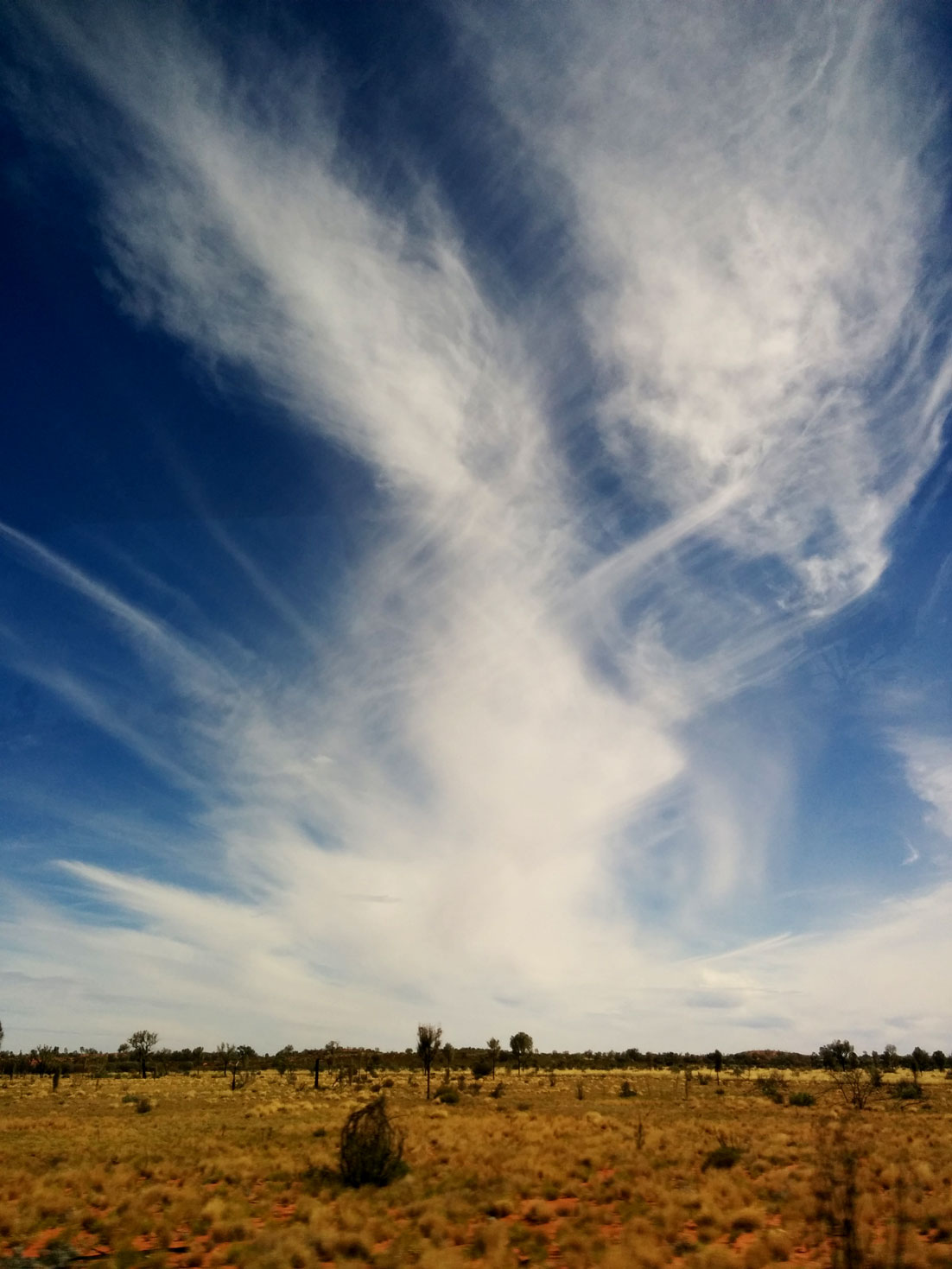
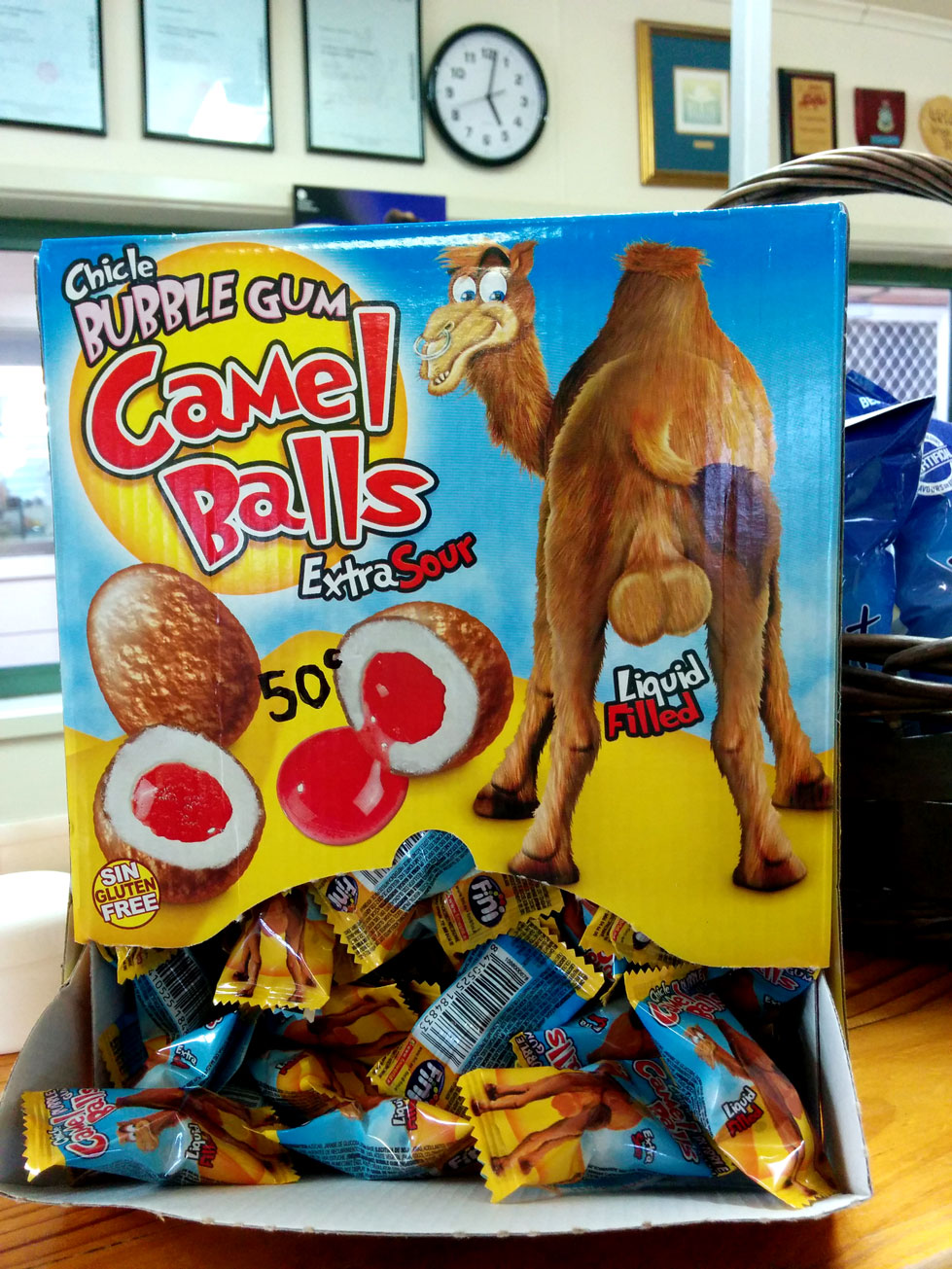
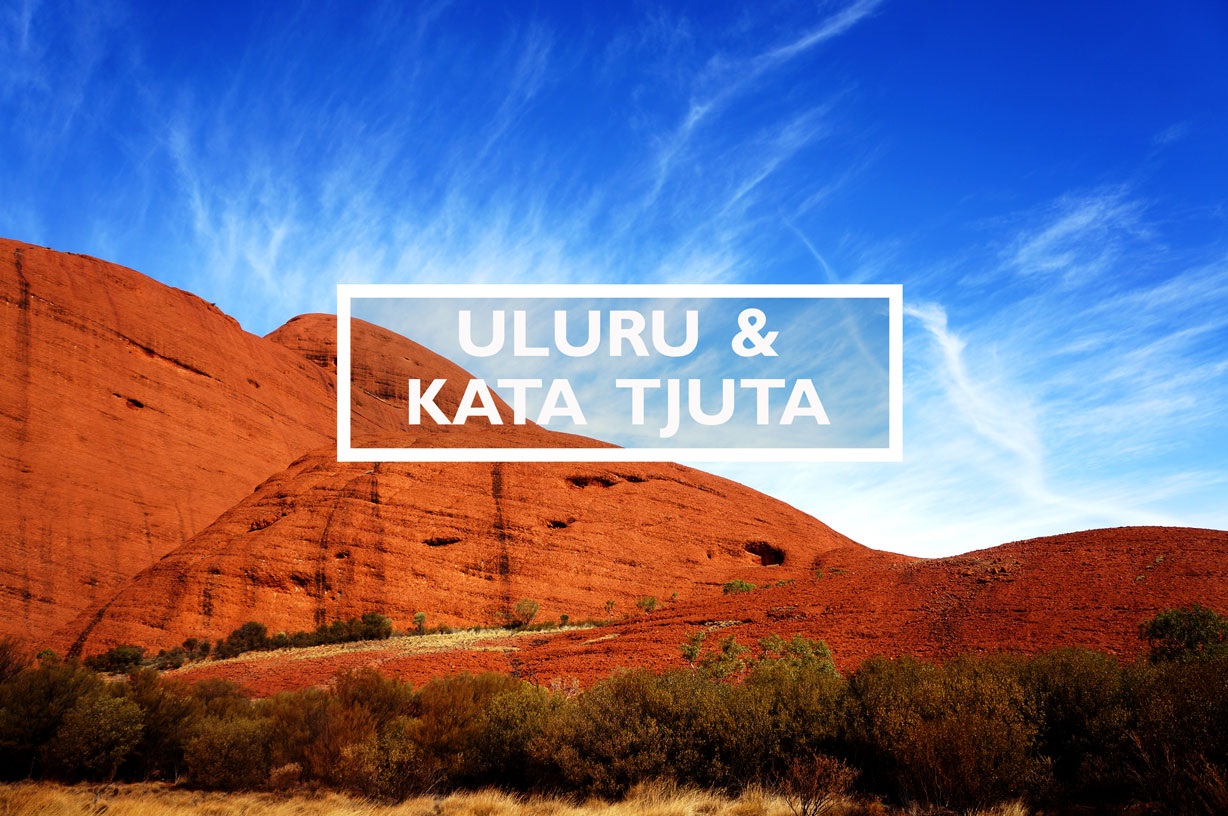
Gee you write well! Beautiful images painted on a rough canvas. Yes, you’ll have to return and do the road trip…. it’s quite a place… from one who lives in the same country, but has never been to the Centre. Bucket List stuff
Ohhhhhhh my god CAMEL BALLS!!!!! Seriously these pics are so great! Amazing colours, fantastic framing. Love love love 🙂
I’m glad you’re doing well. Keep photographing (and posting) your adventures for those of us stuck at home, not travelling the world 😉
Thanks Maray! 😀
I’m trying to channel you when I take a shot…by the end of this year, I should have a few more to submit to competitions! Will need your help for that again.
Love this. Your sense of wonder is infectious. It’s not just about the sights; it’s also how they look, smell and sound at those exact moments and how they make you FEEL. I definitely HAVE to make the trip out there!
P.S. that flower … it’s a grevillea 😉
I’m so glad that’s coming through! I’m trying to transport readers to the space as best as I can! It’s really nice to know you’re enjoying the posts. 🙂
I loved this one. The writing and pics. I am sure you have hundreds more pictures to see.
Can’t wait to see.
Silvia! Your photos are amazing and I love reading (and feeling!) your adventures. Keep em coming. Love and miss you x